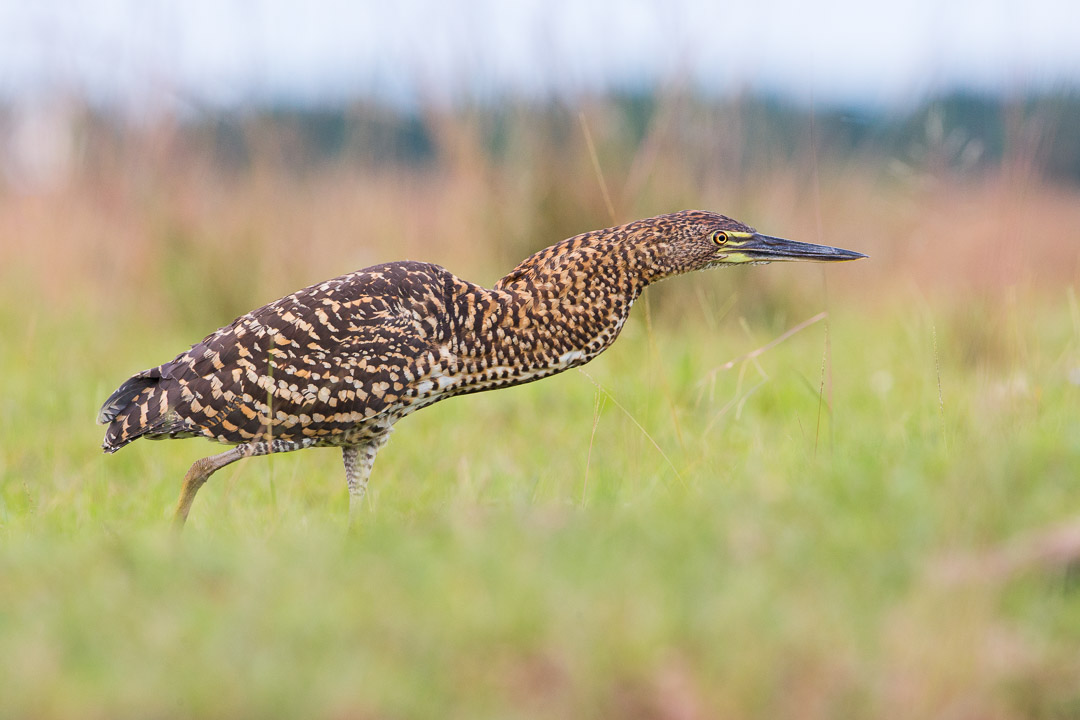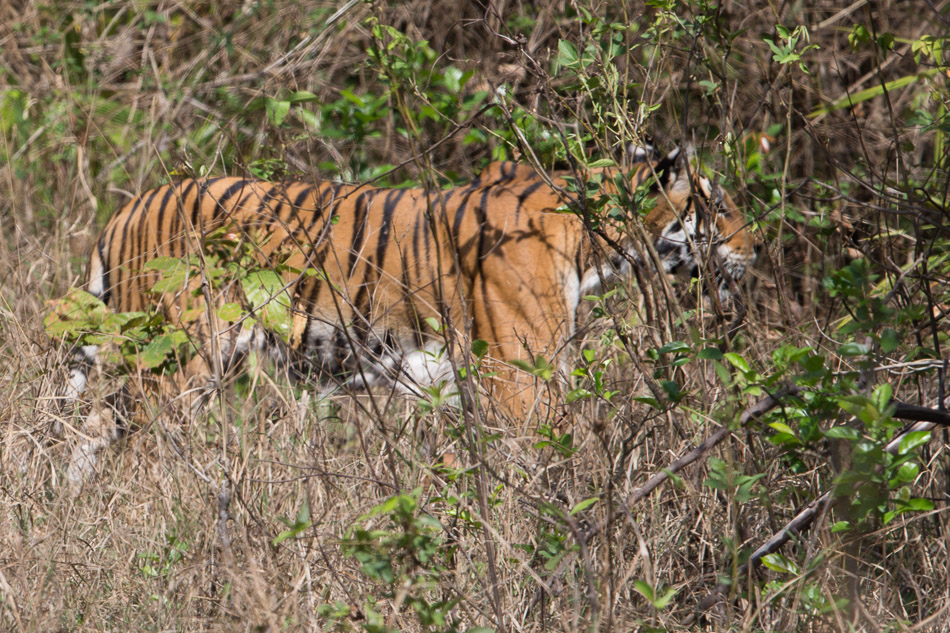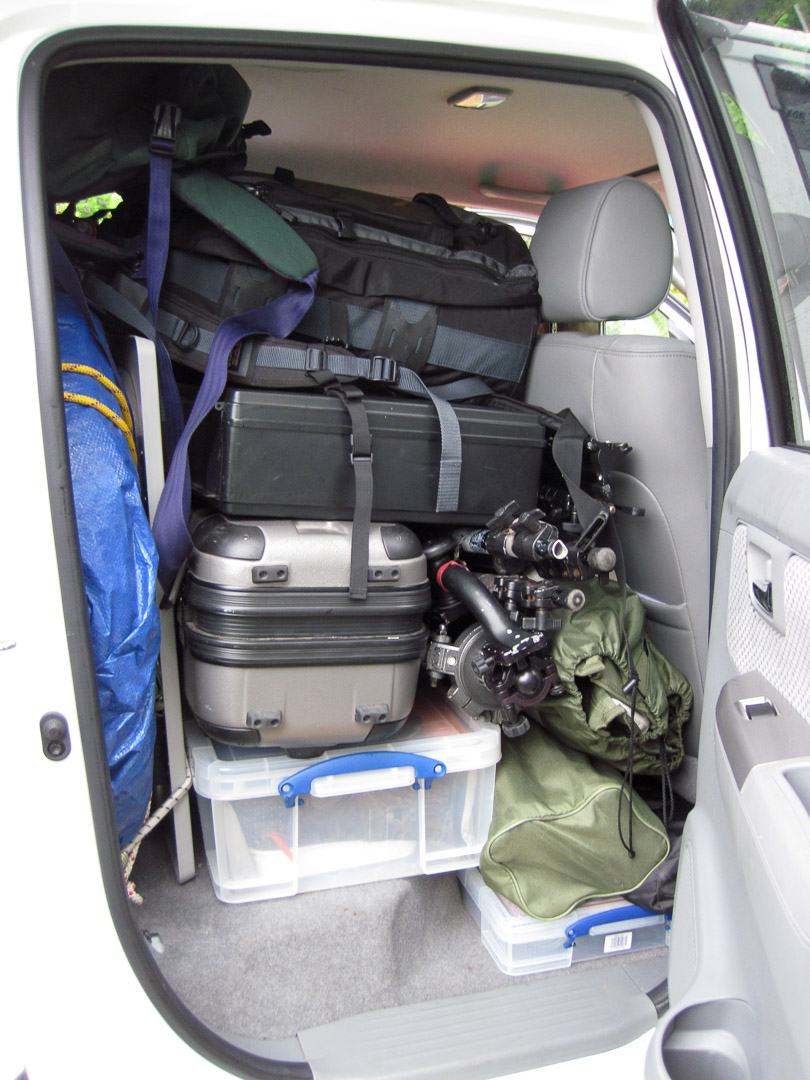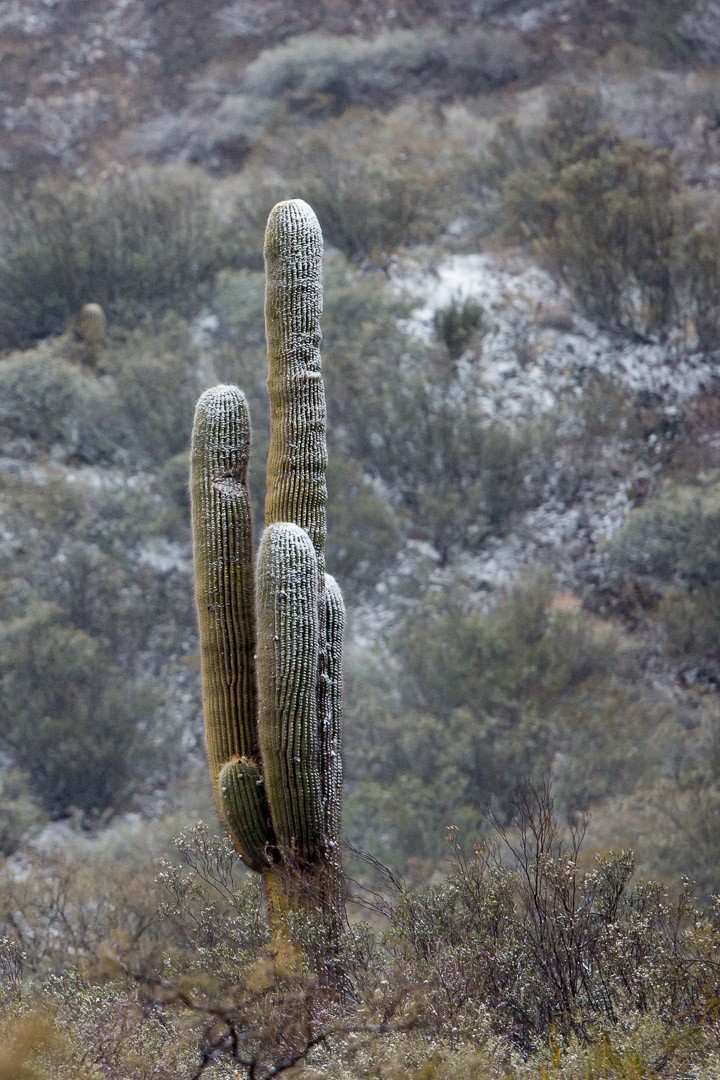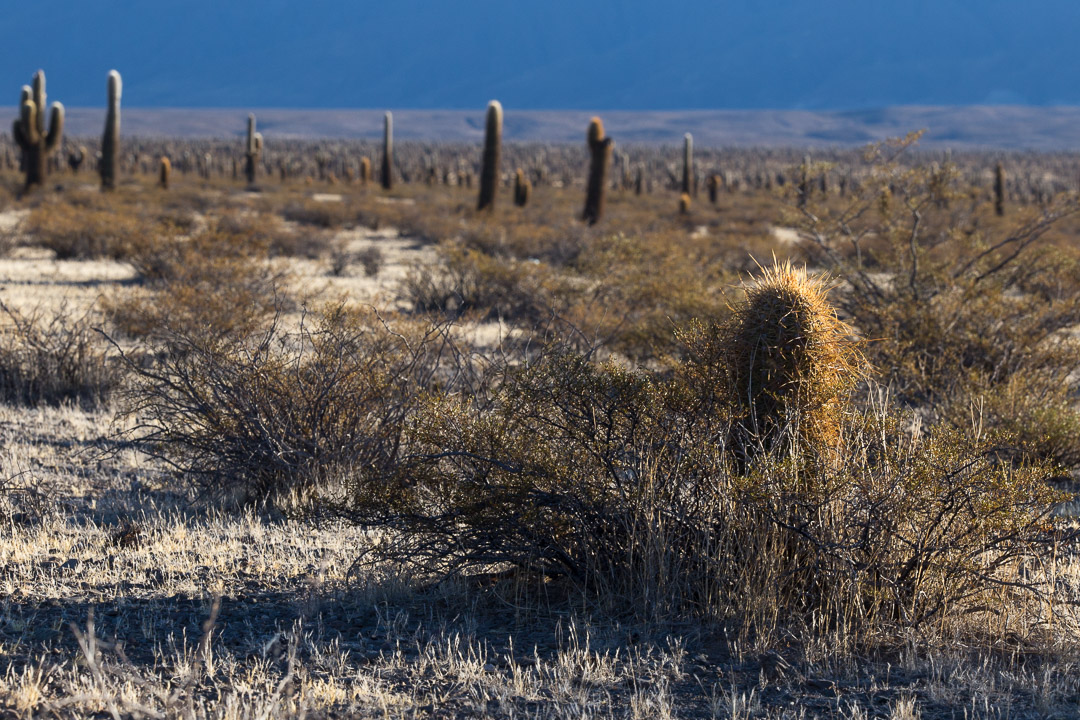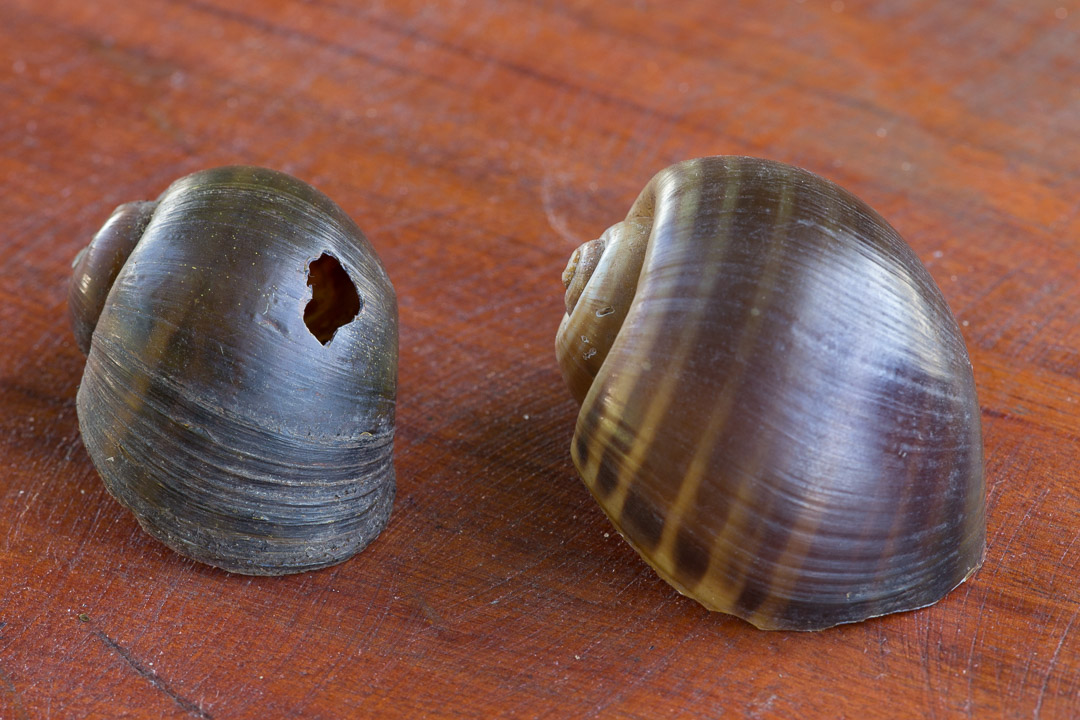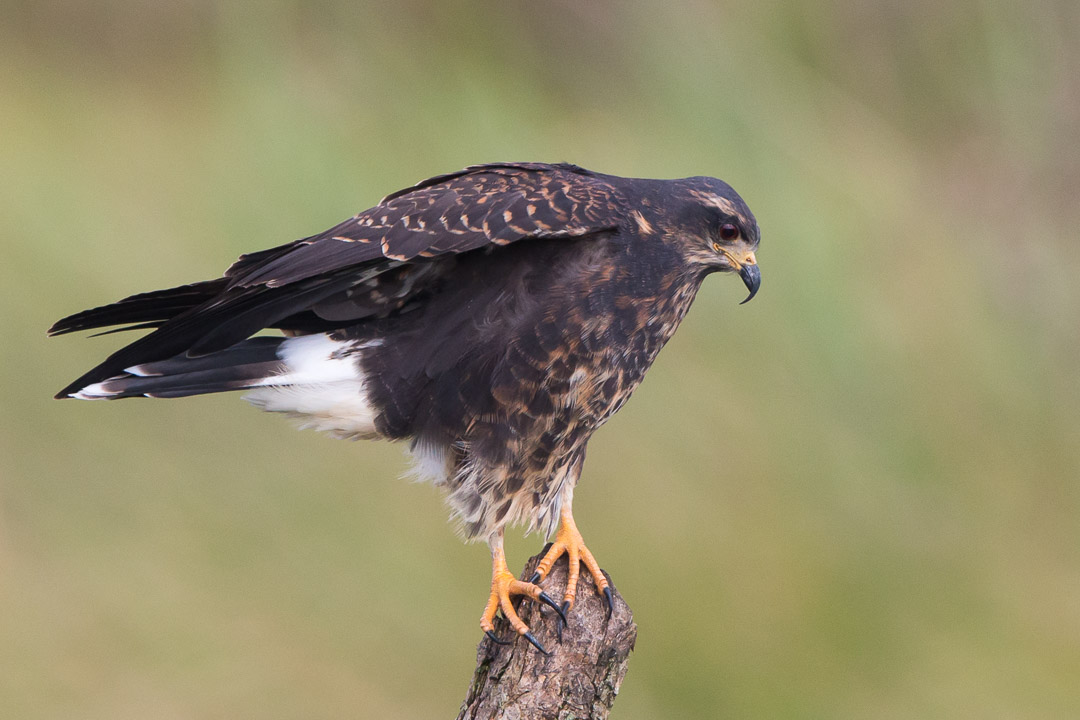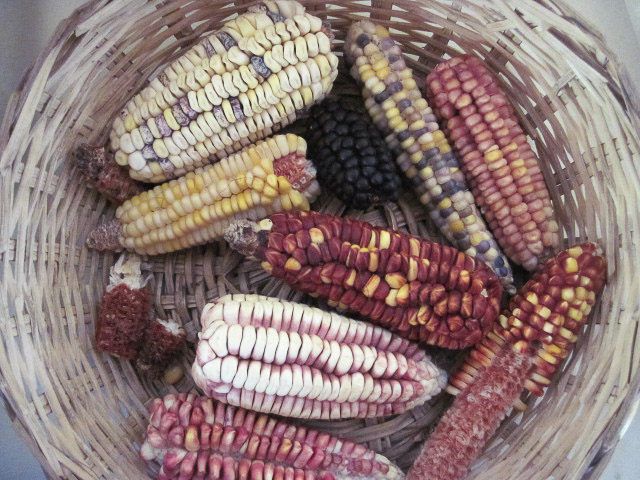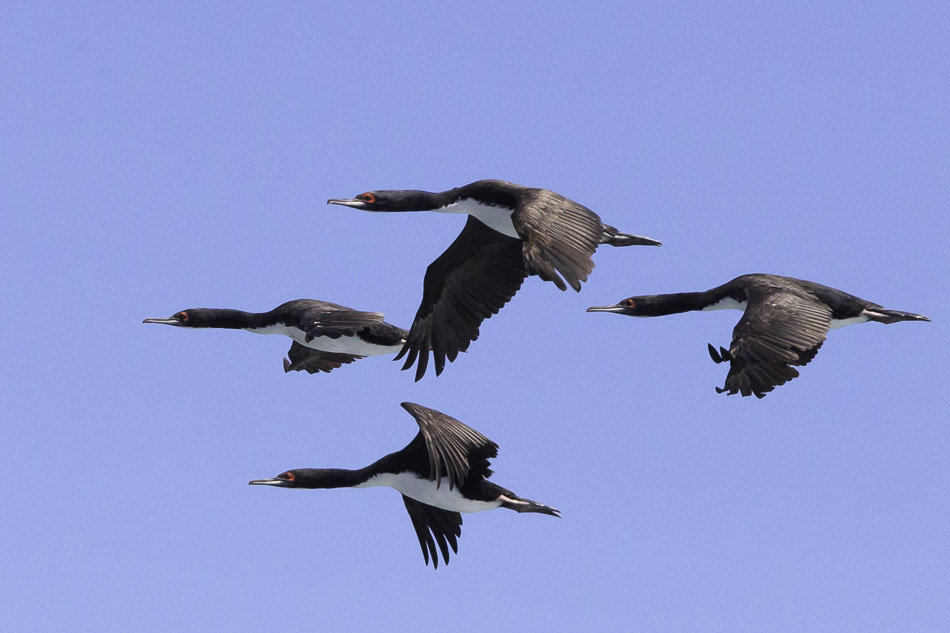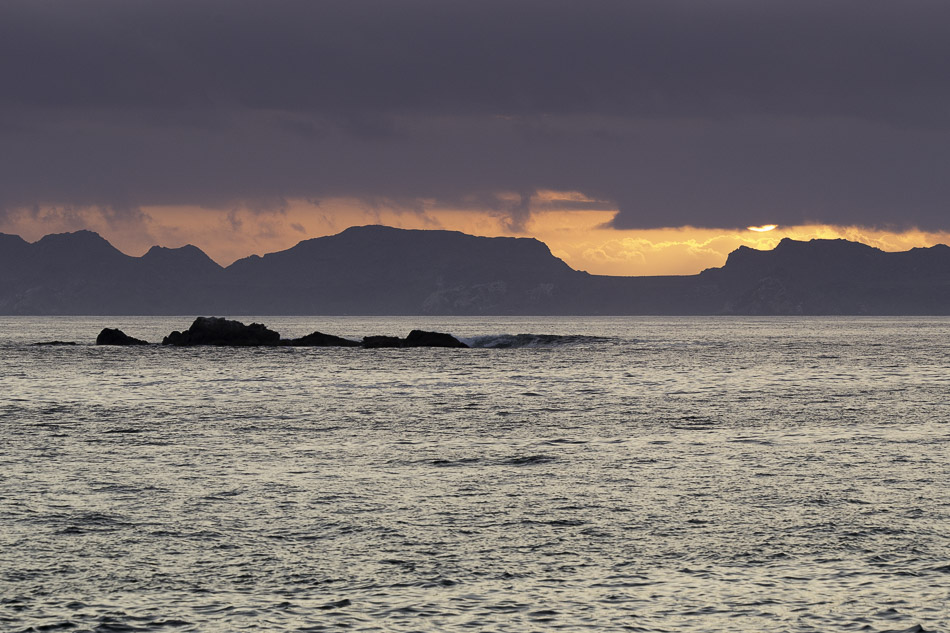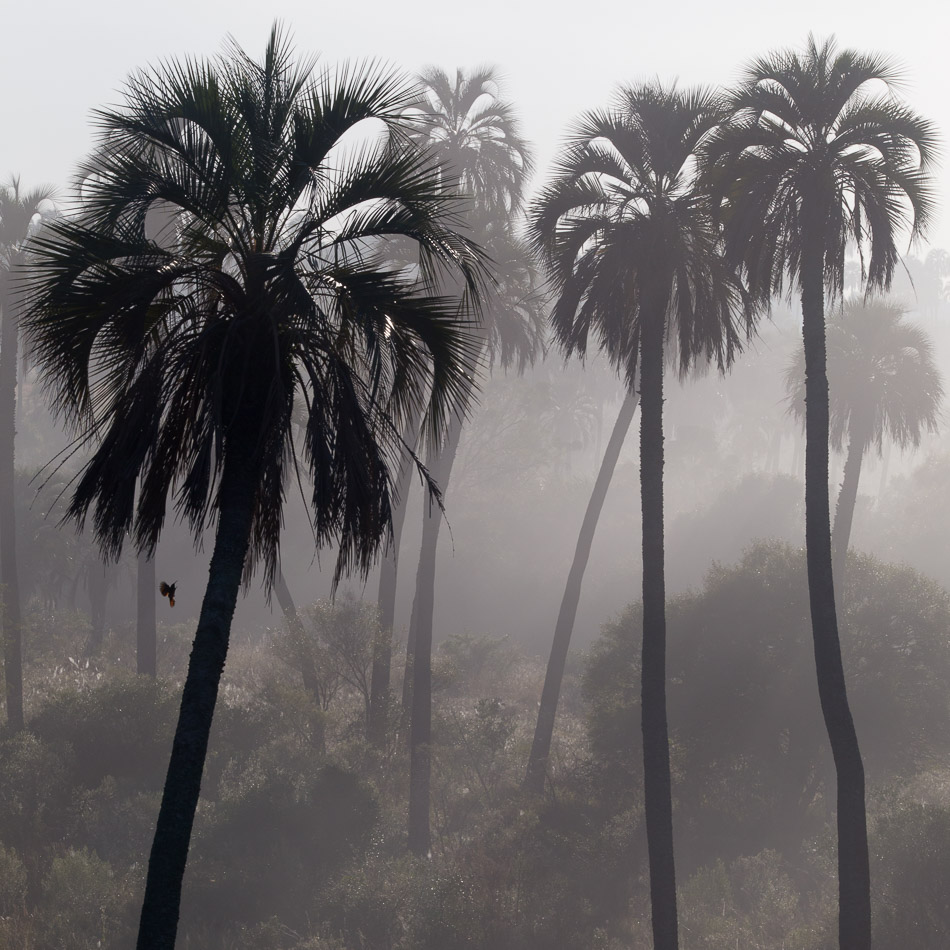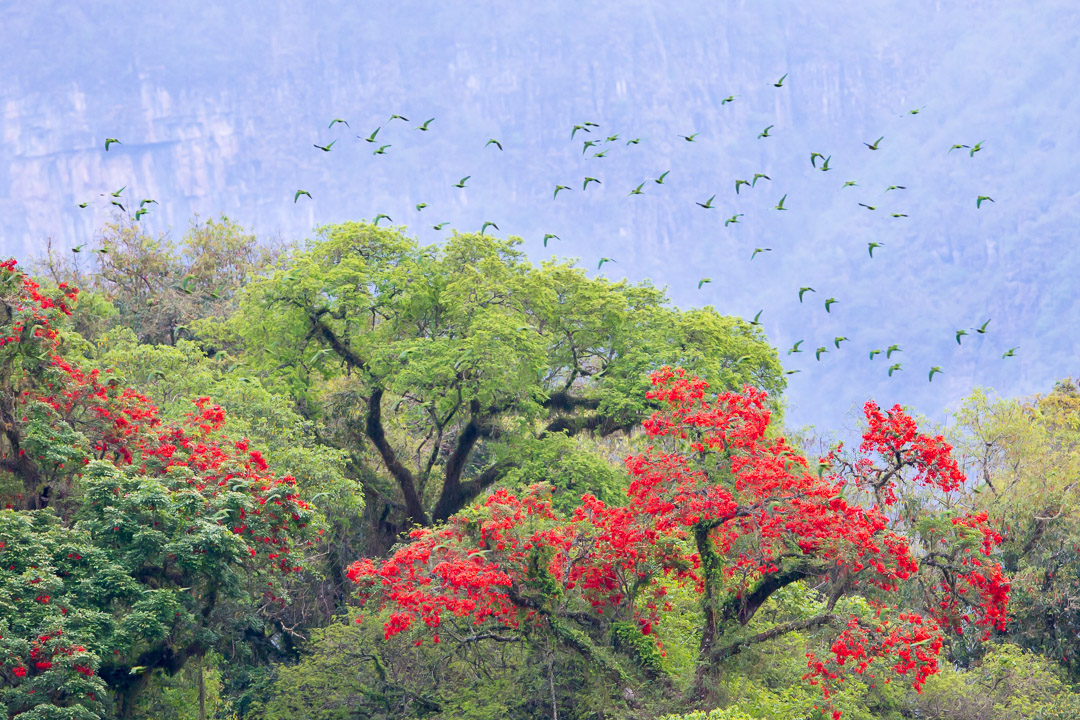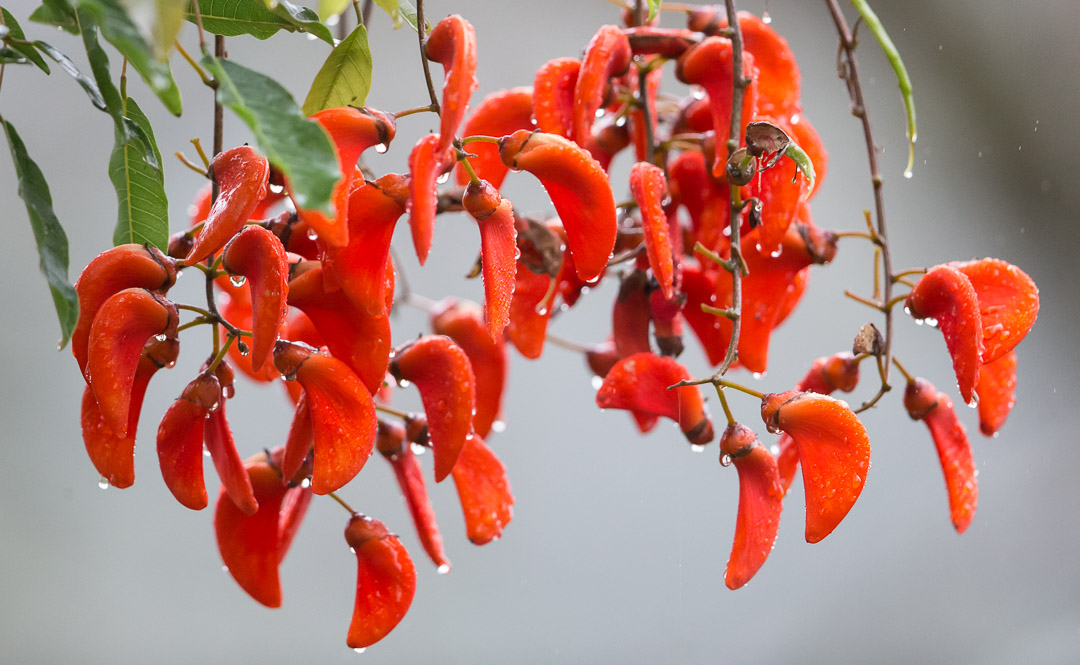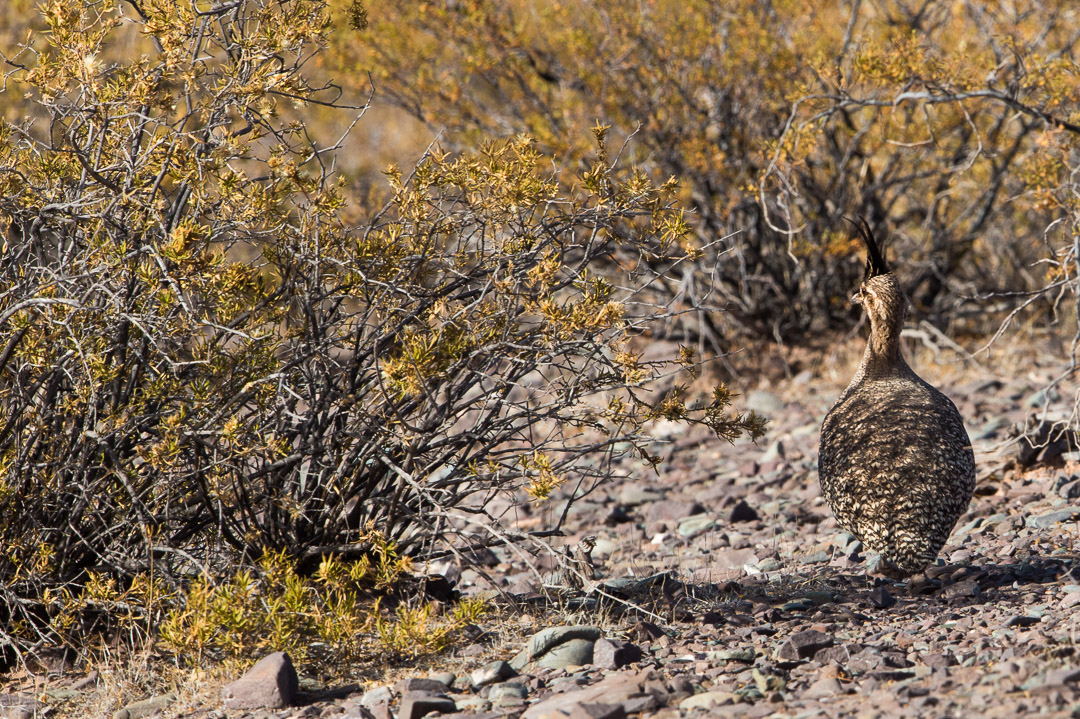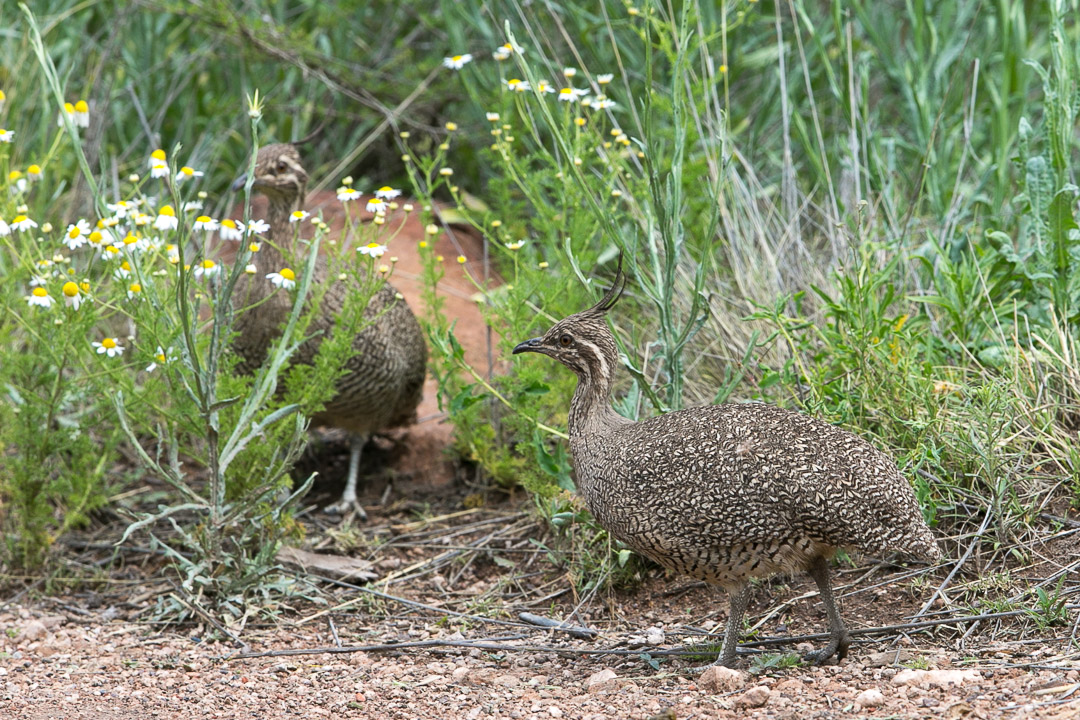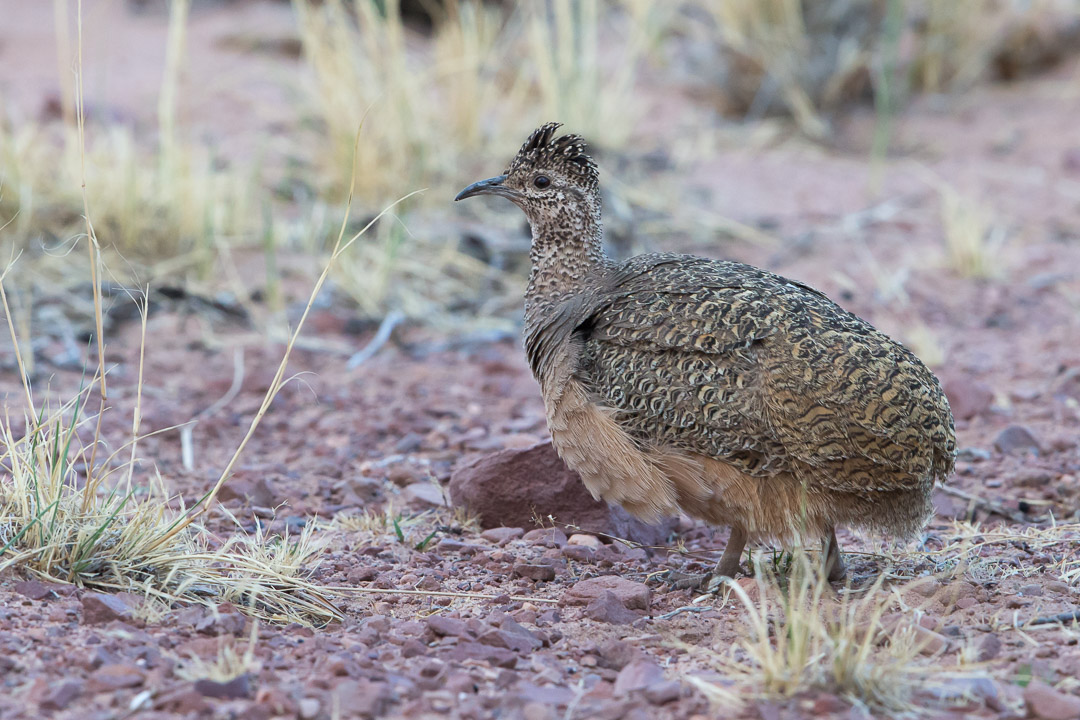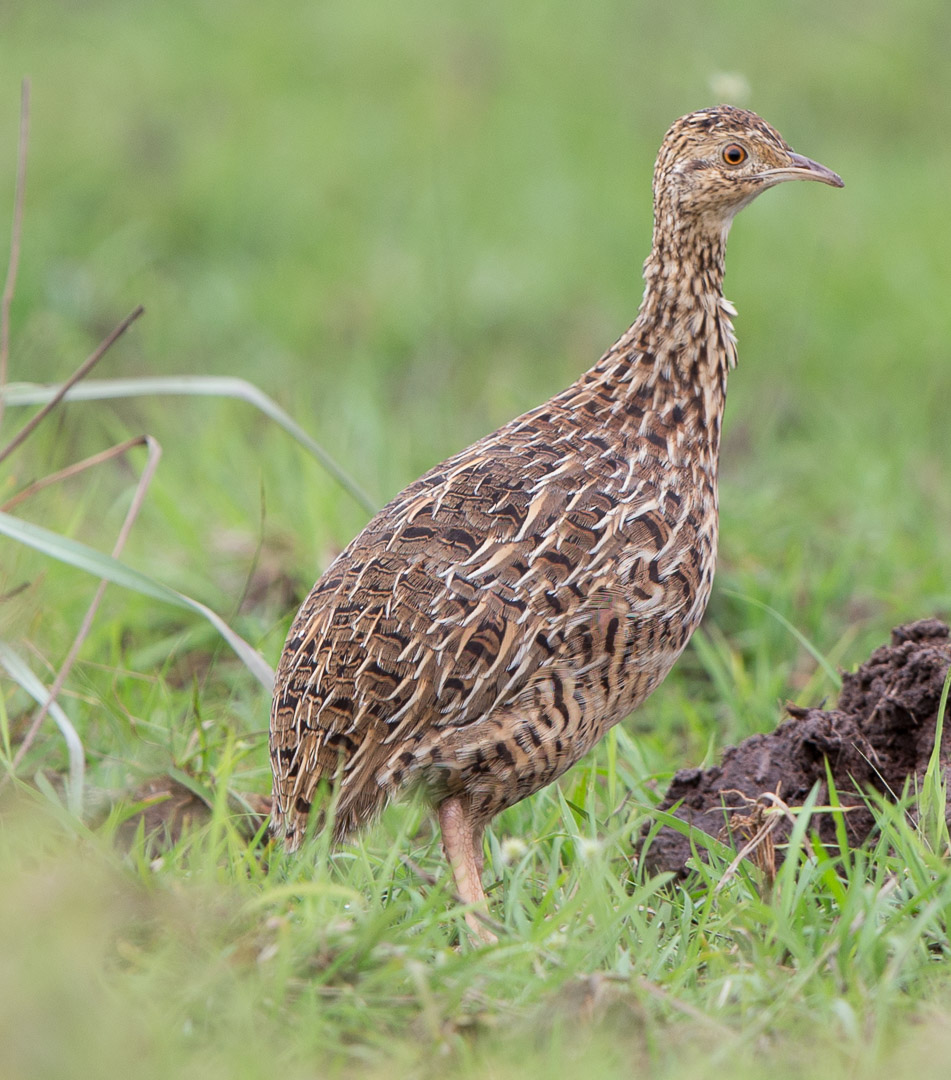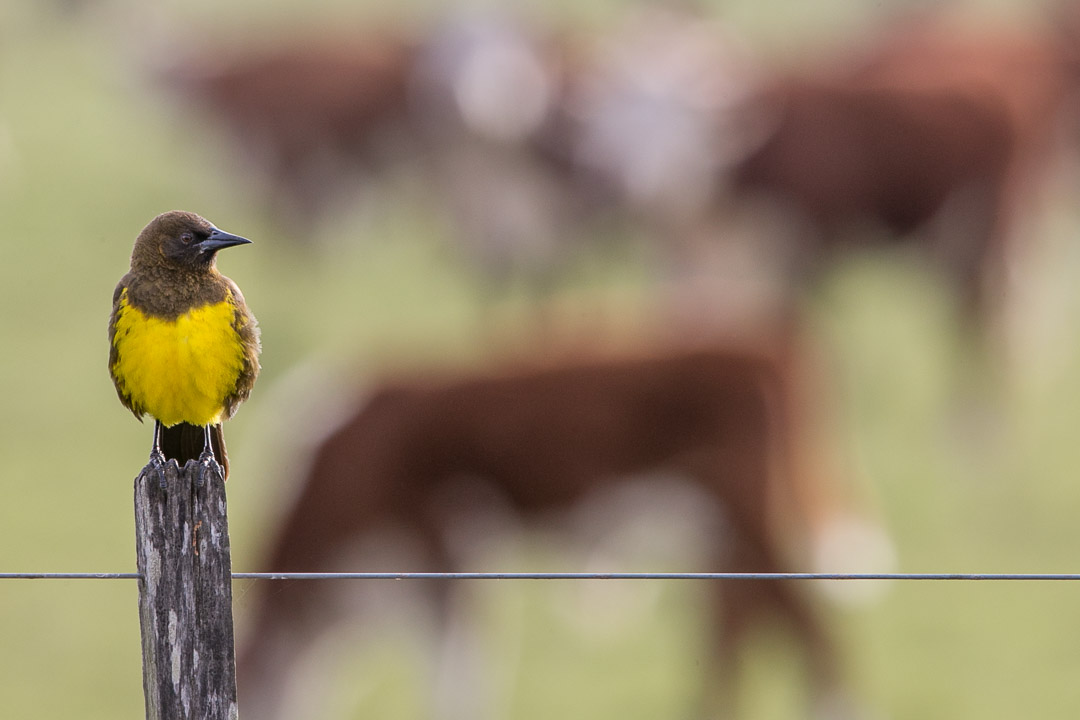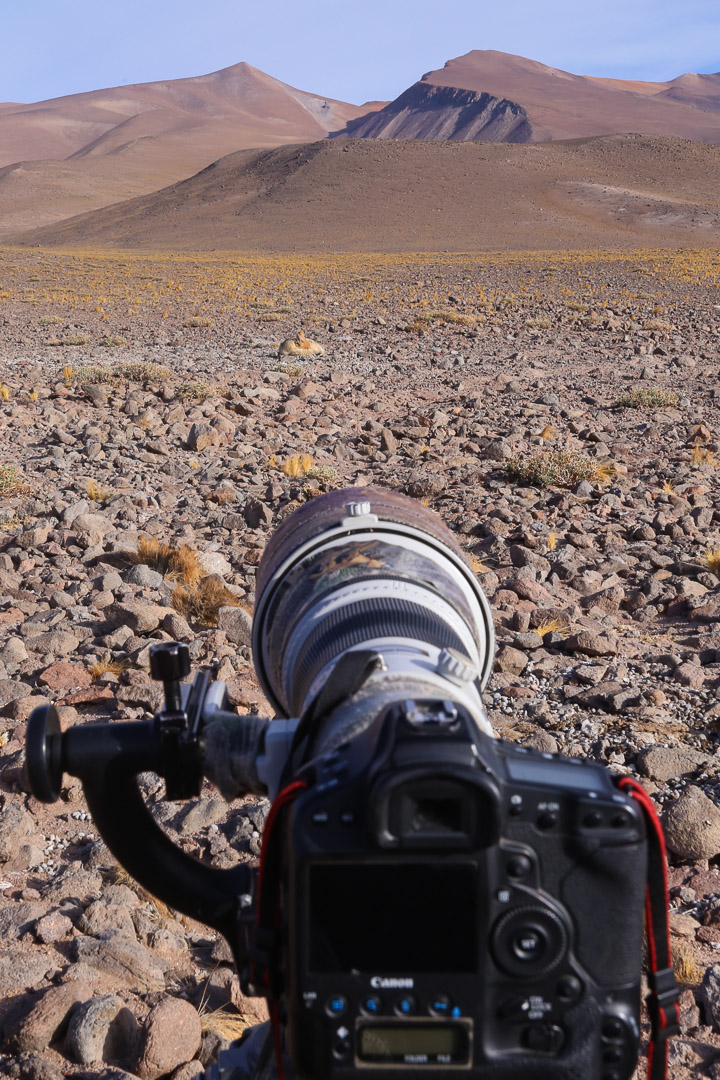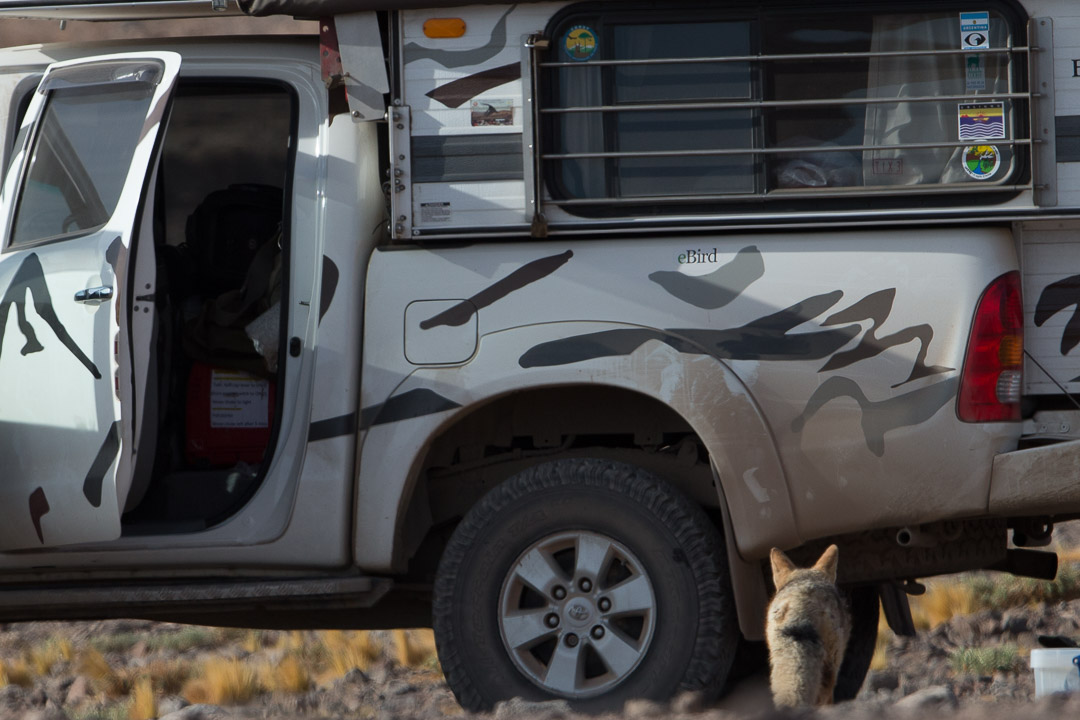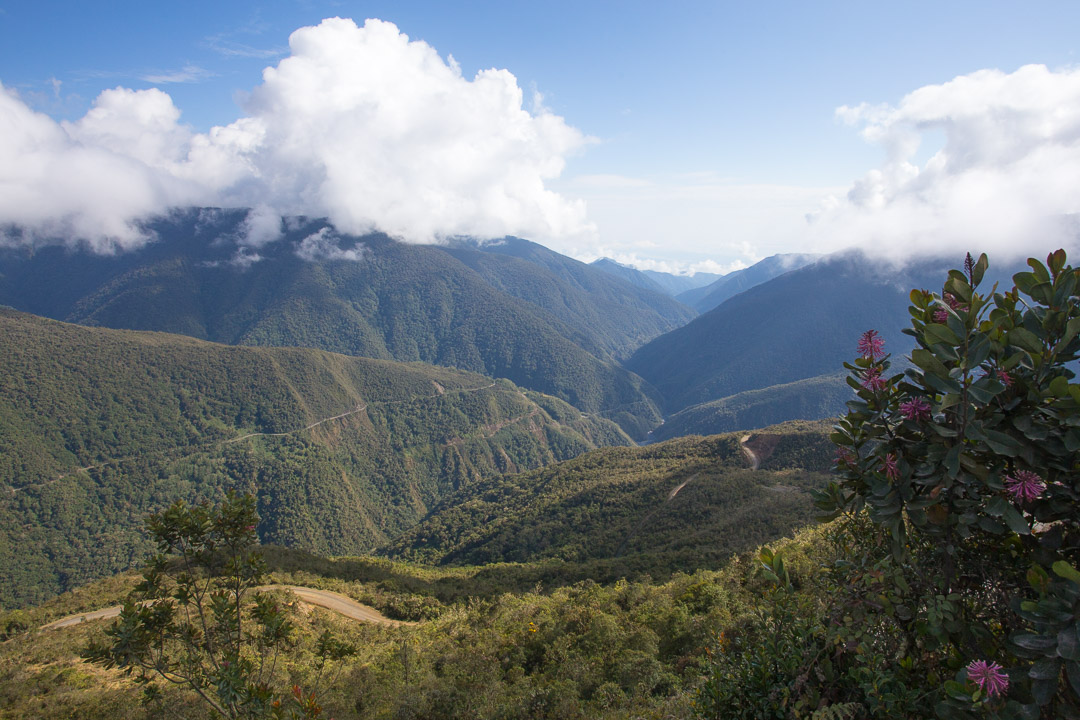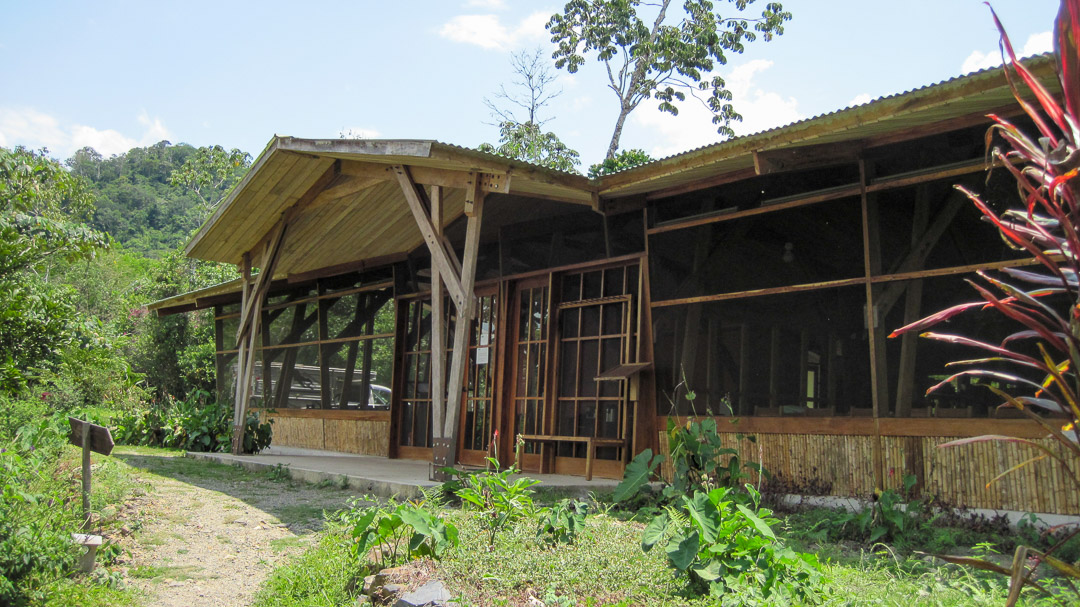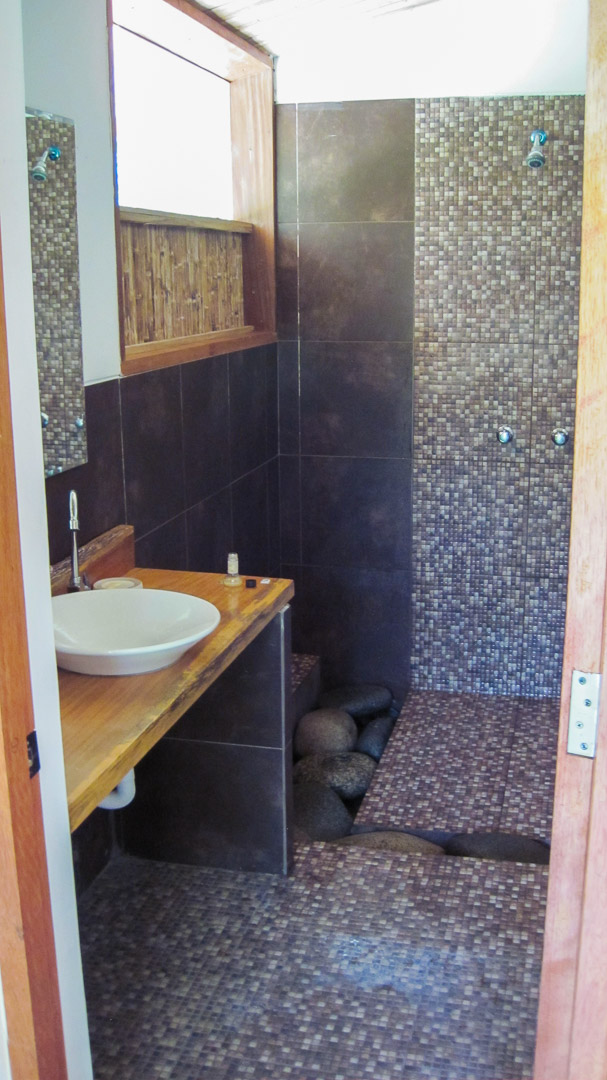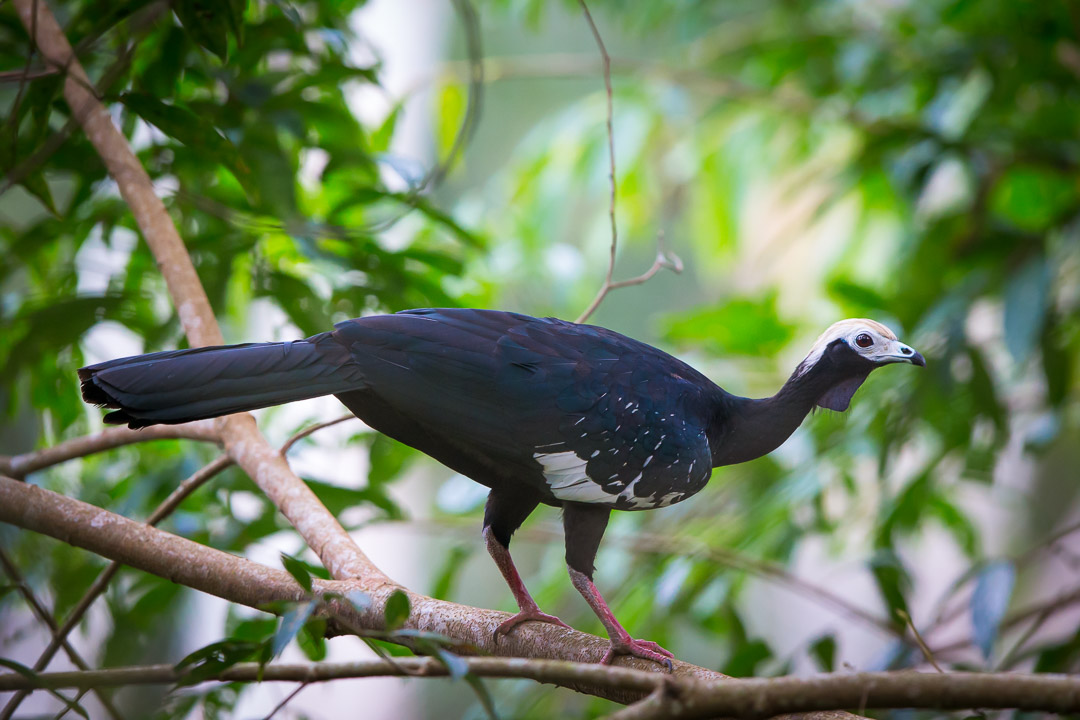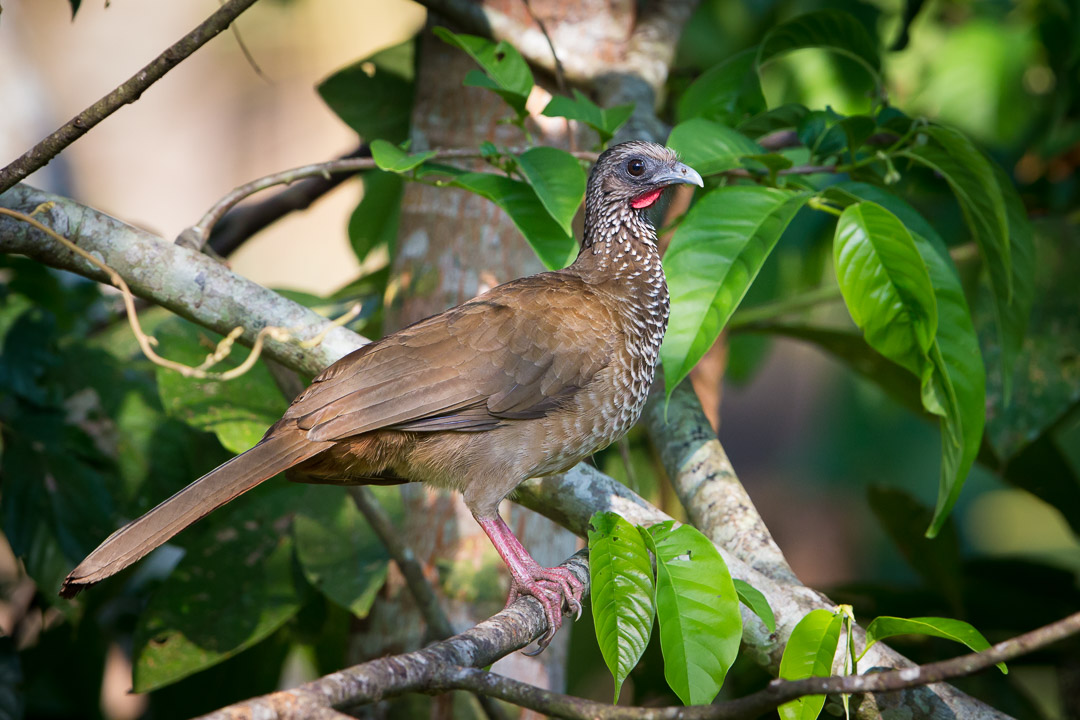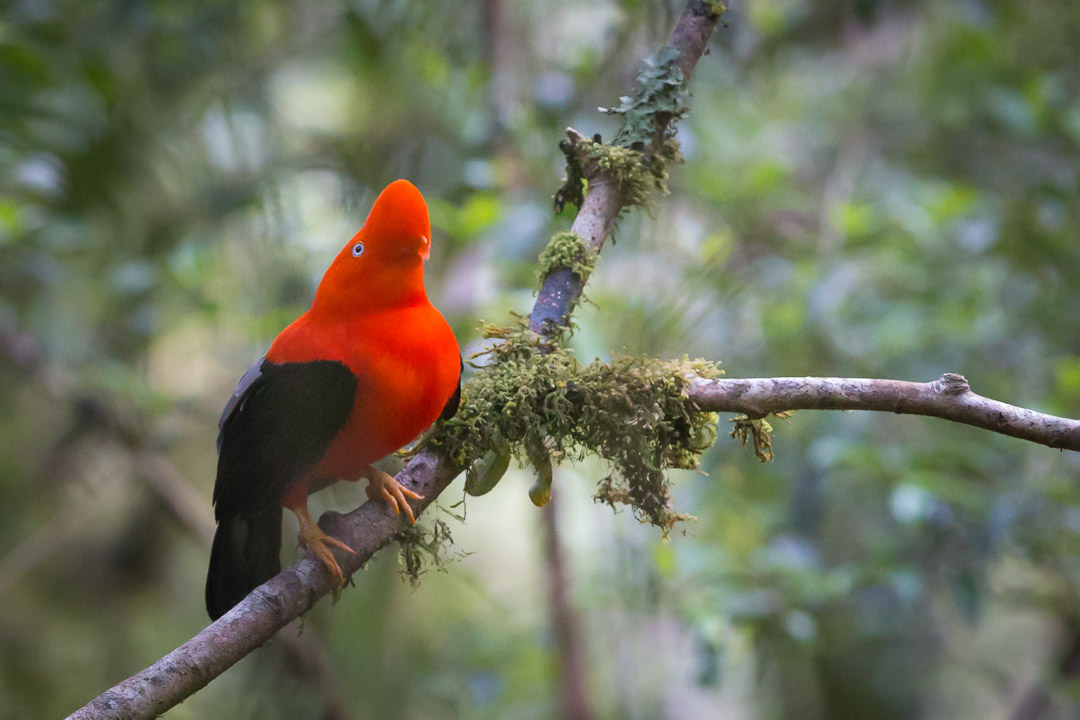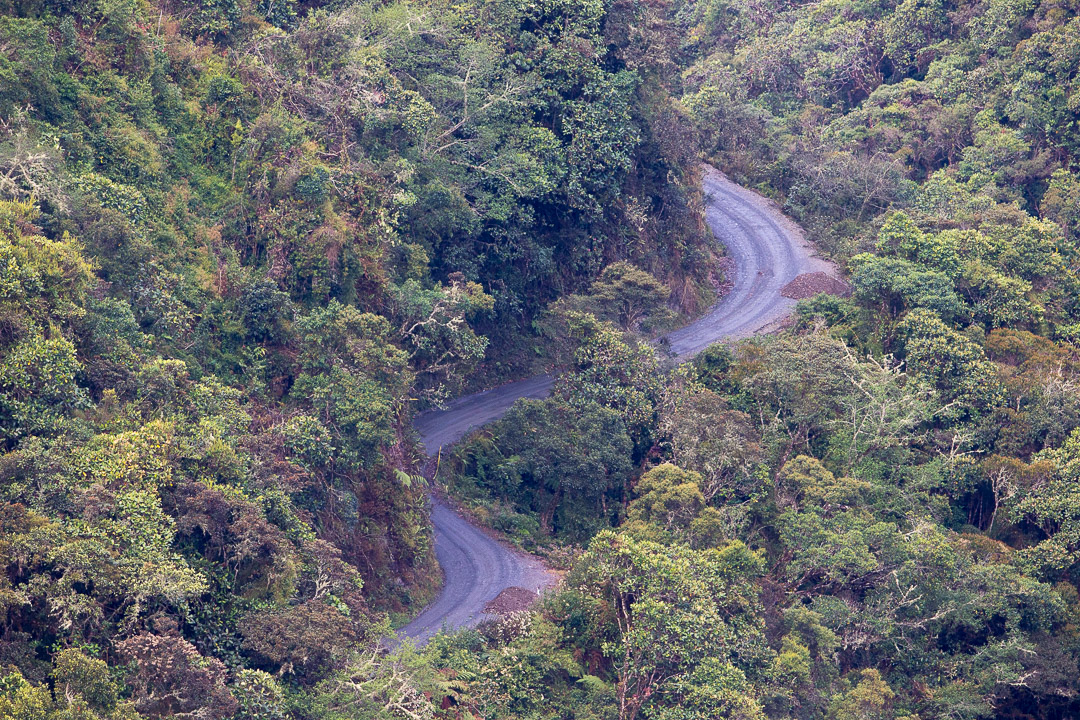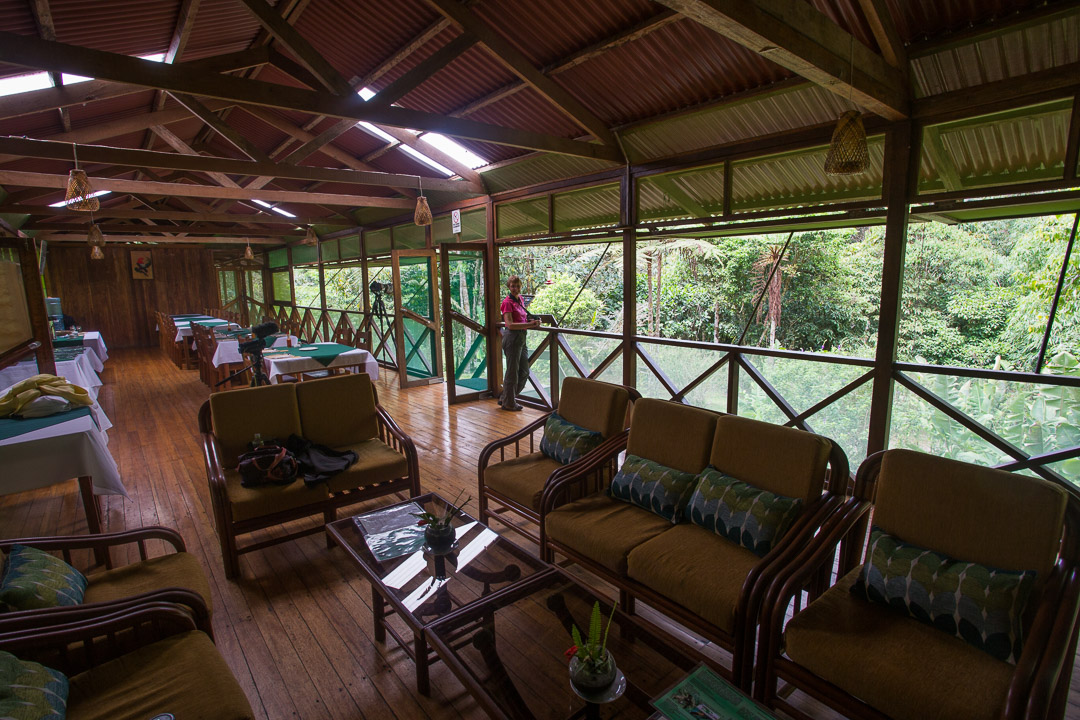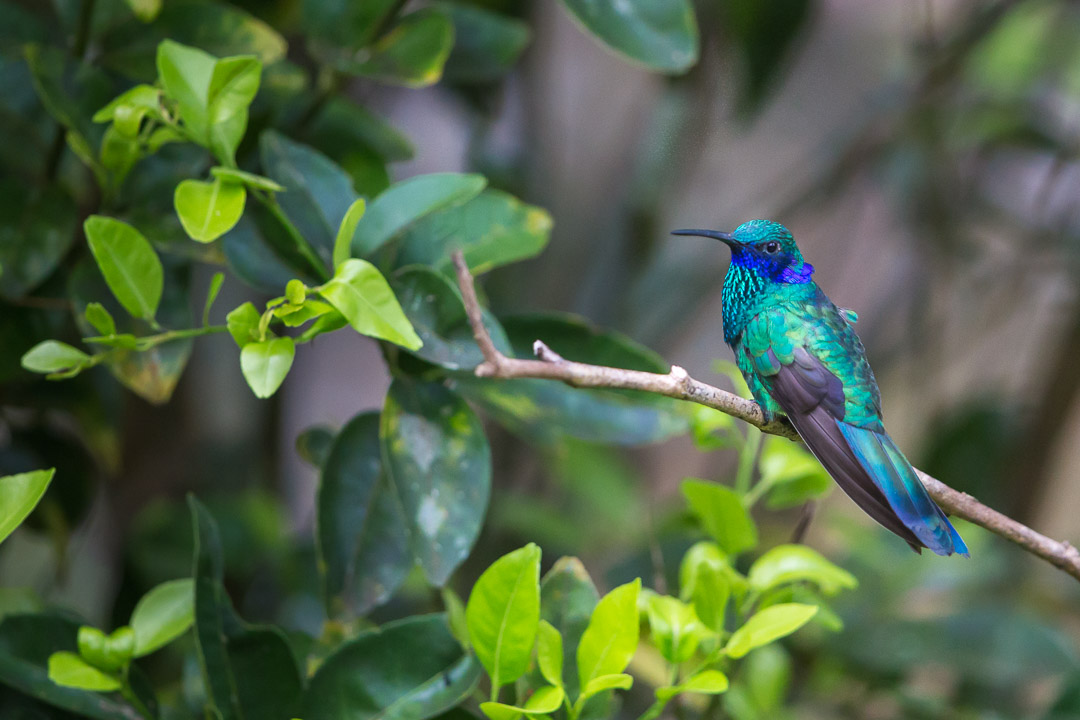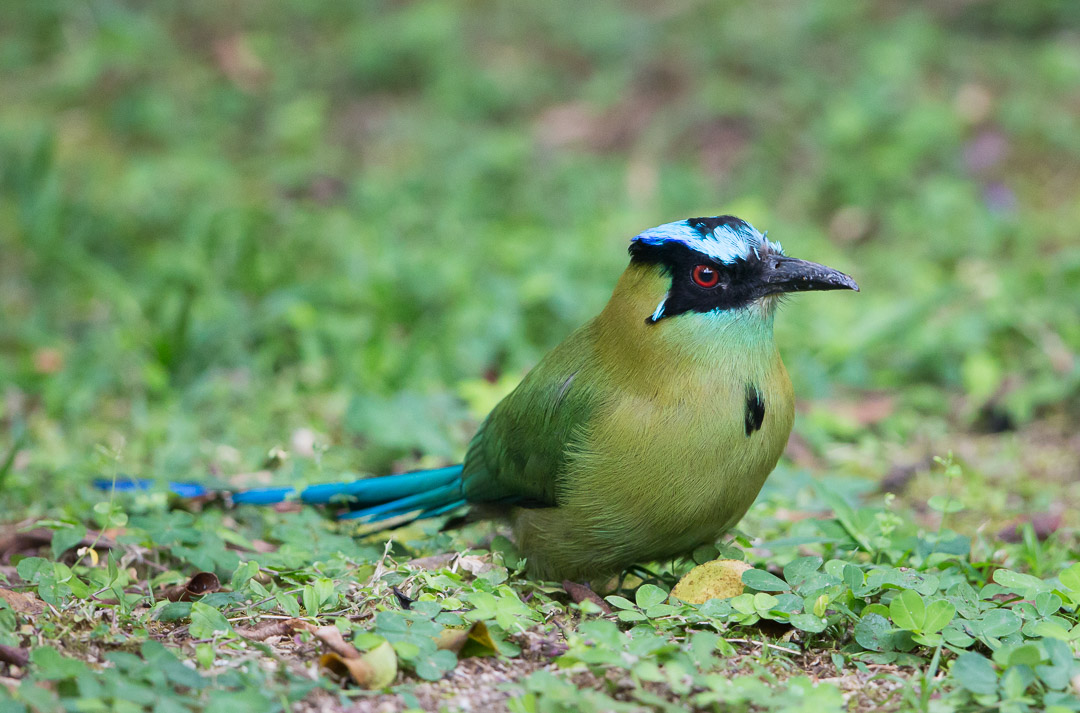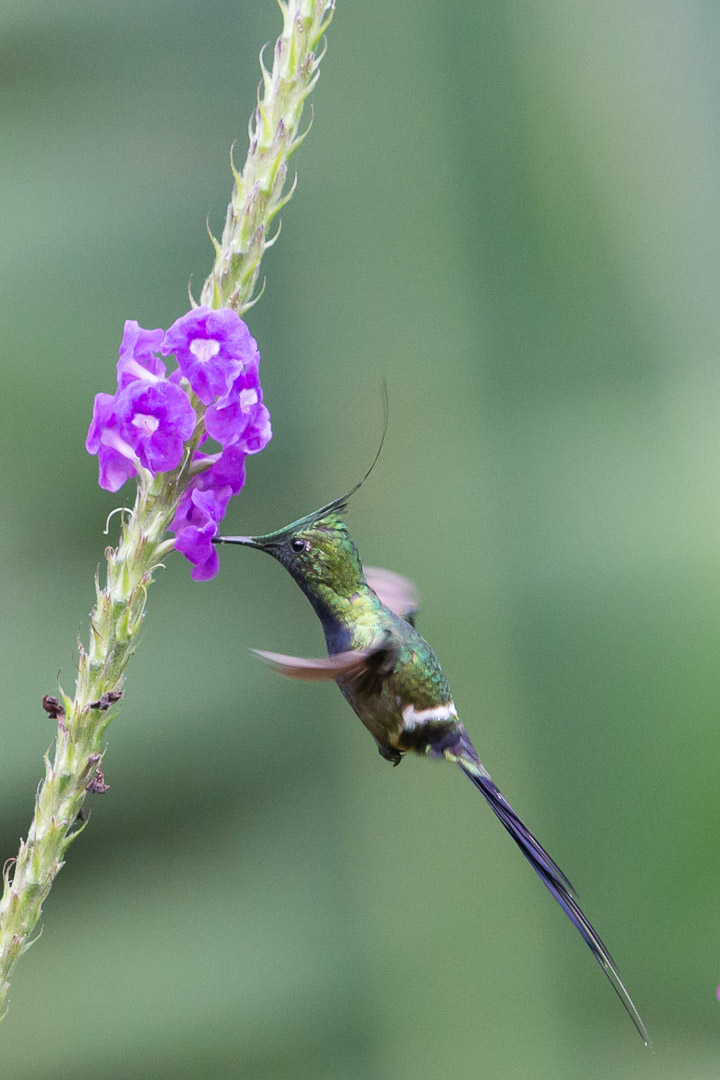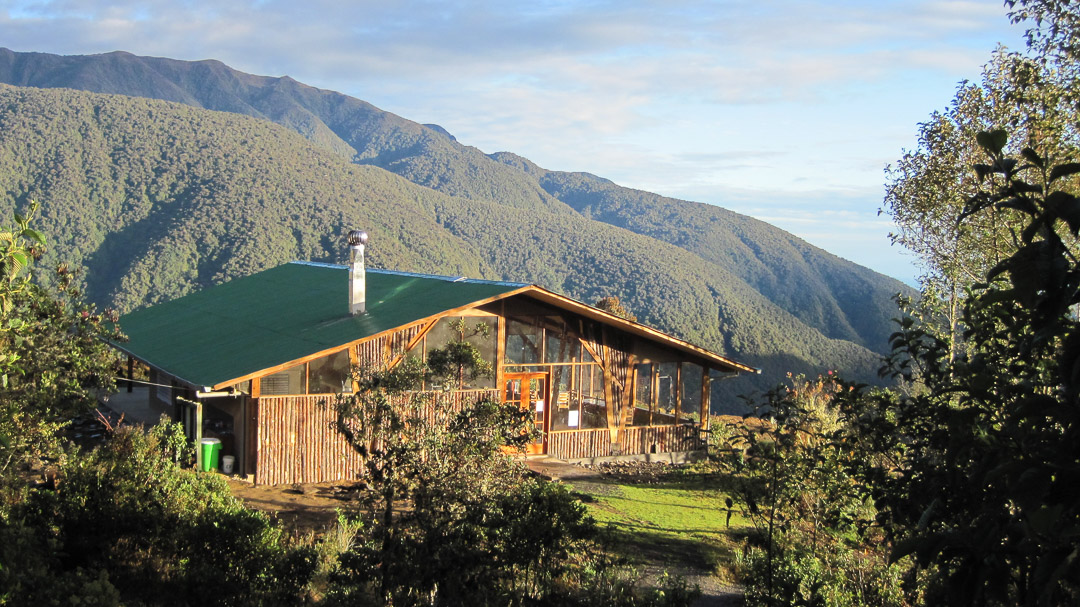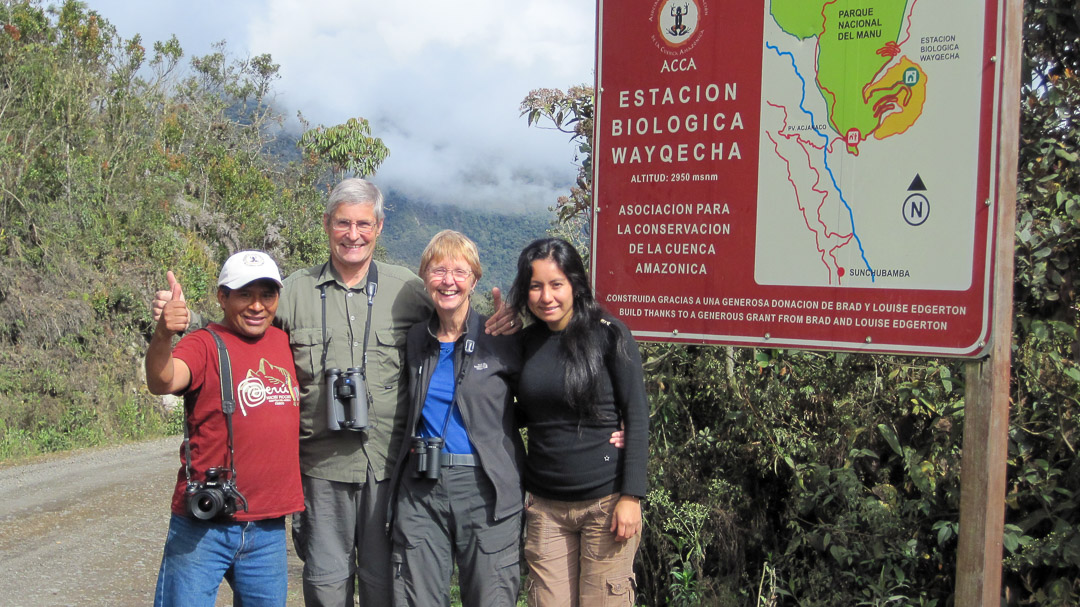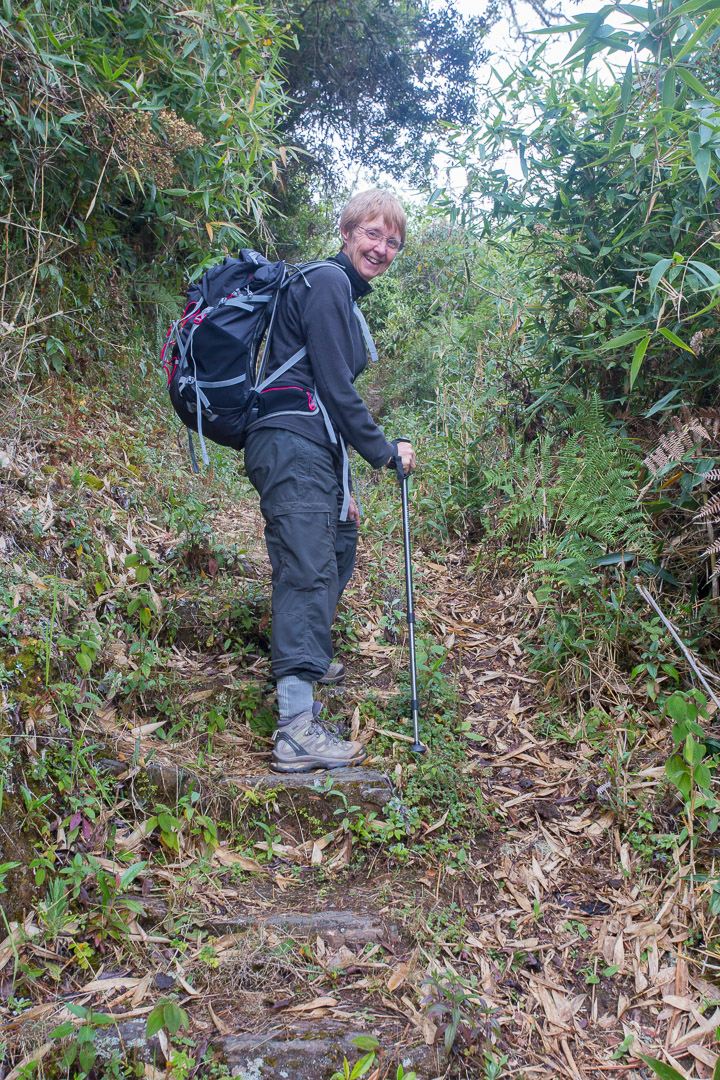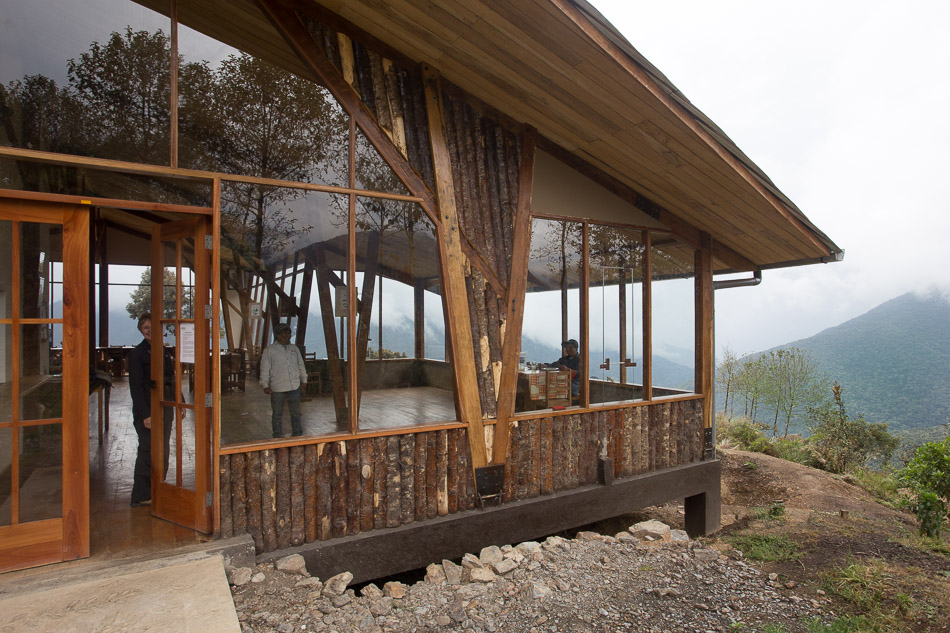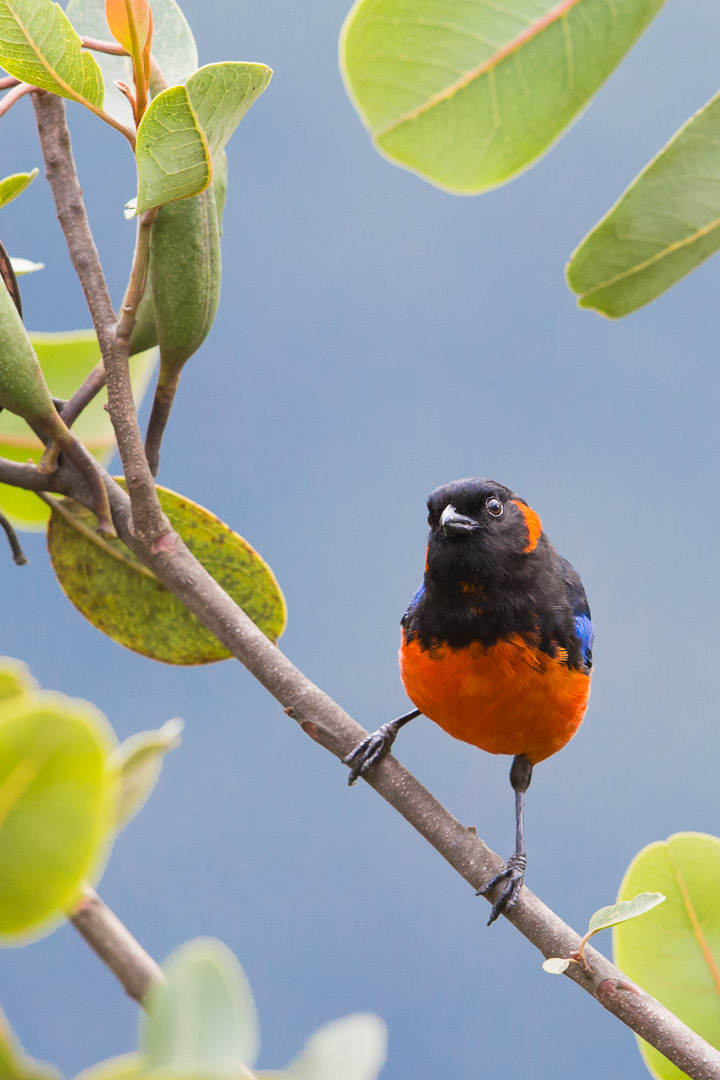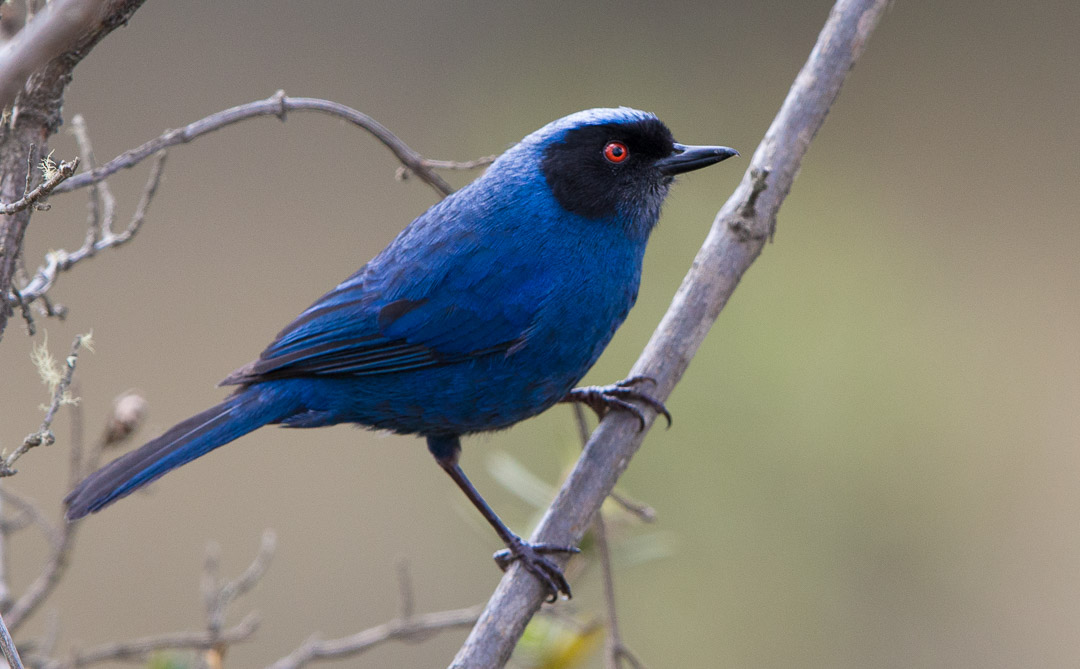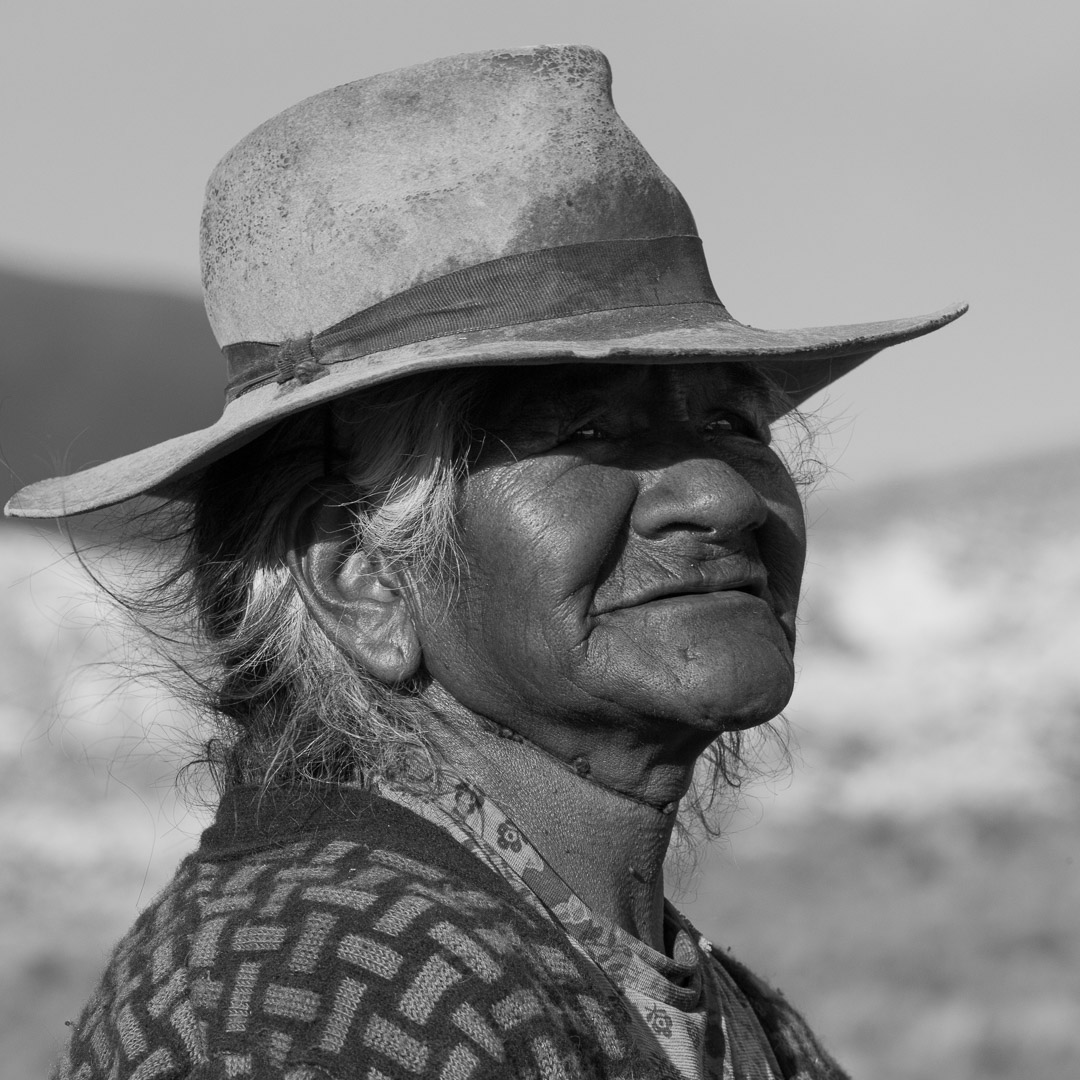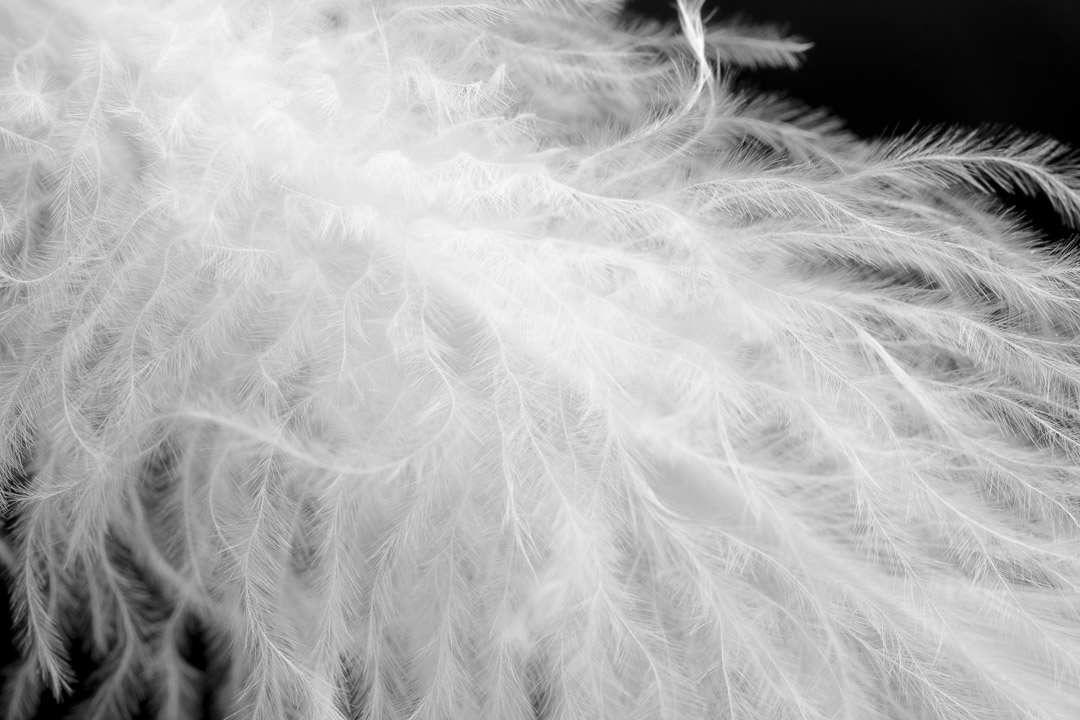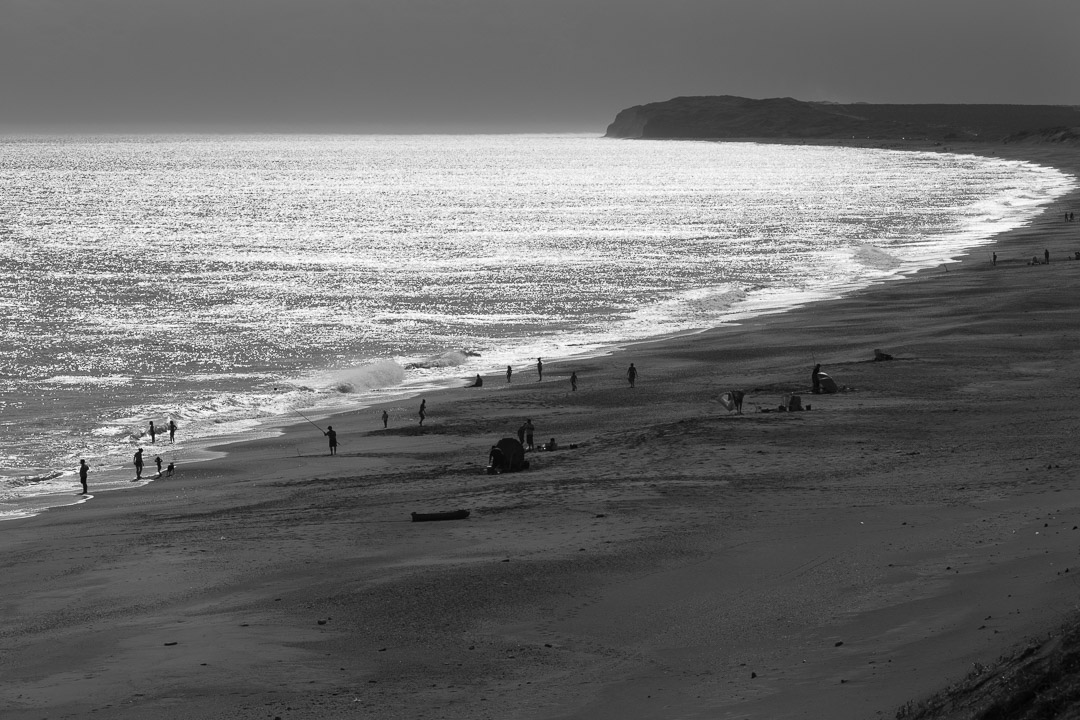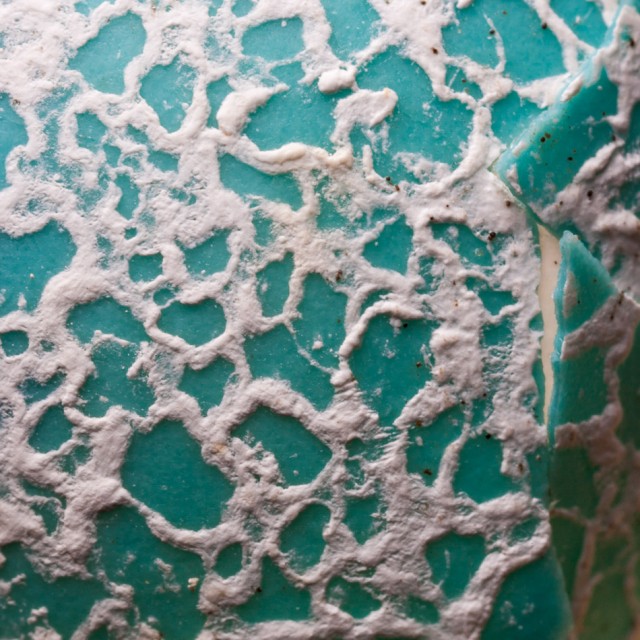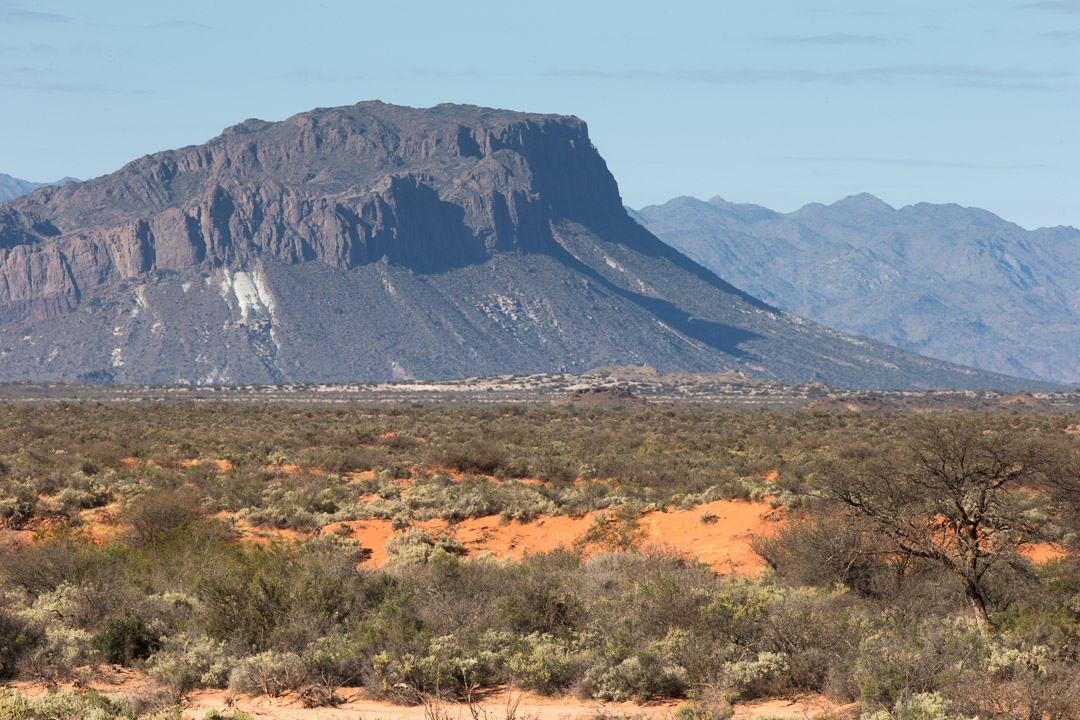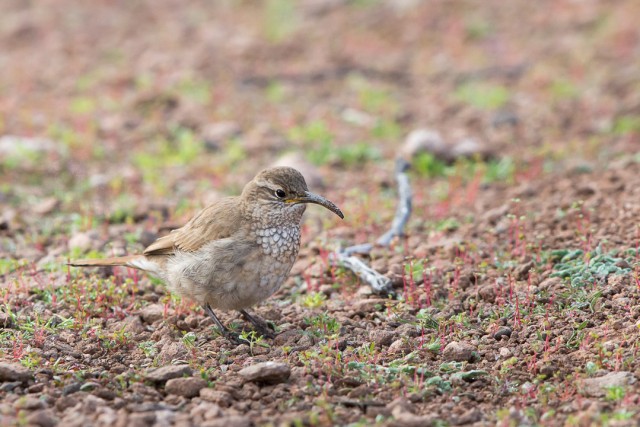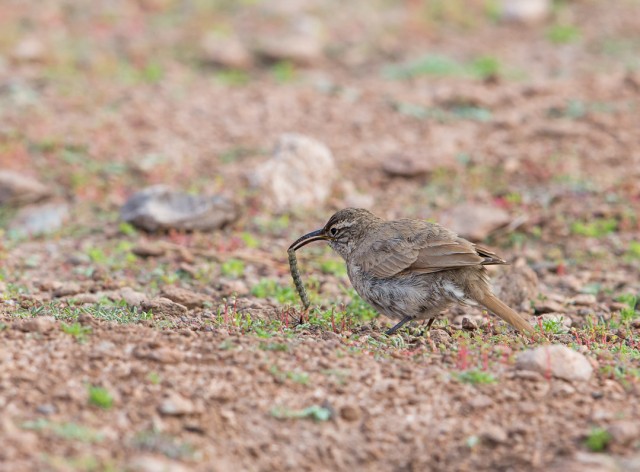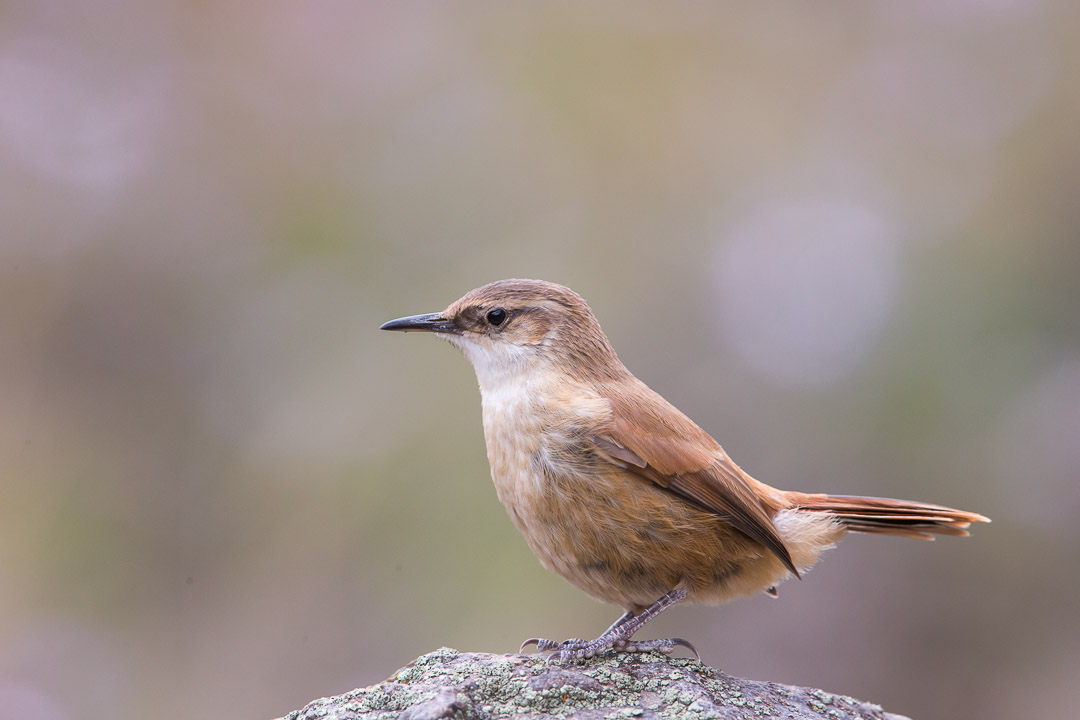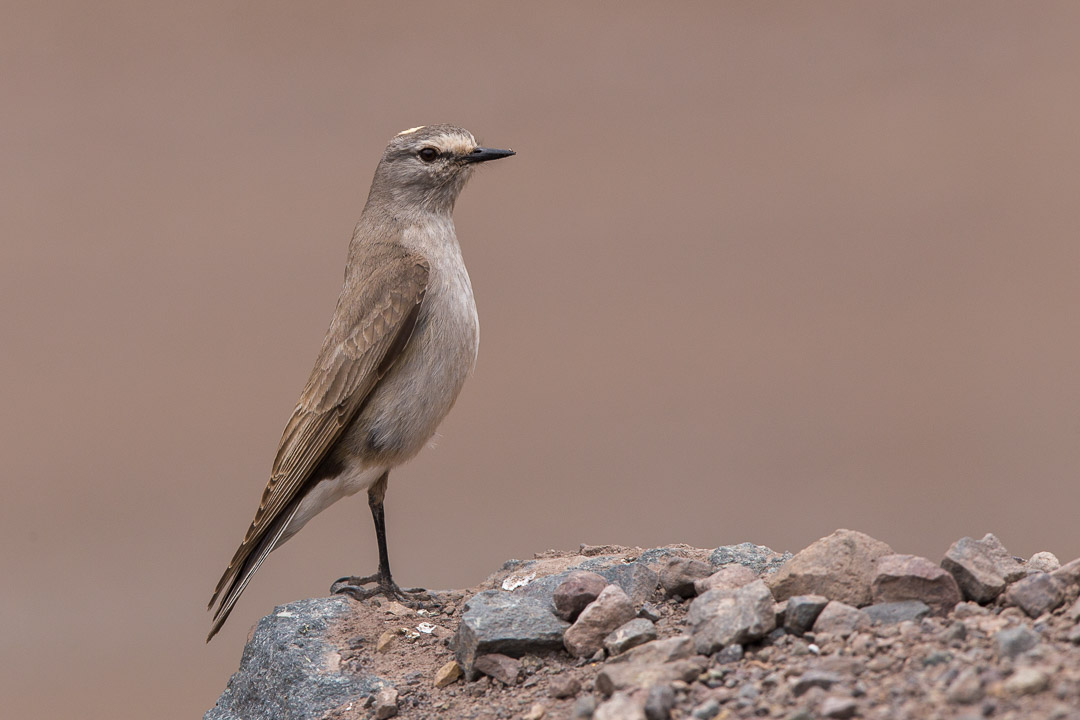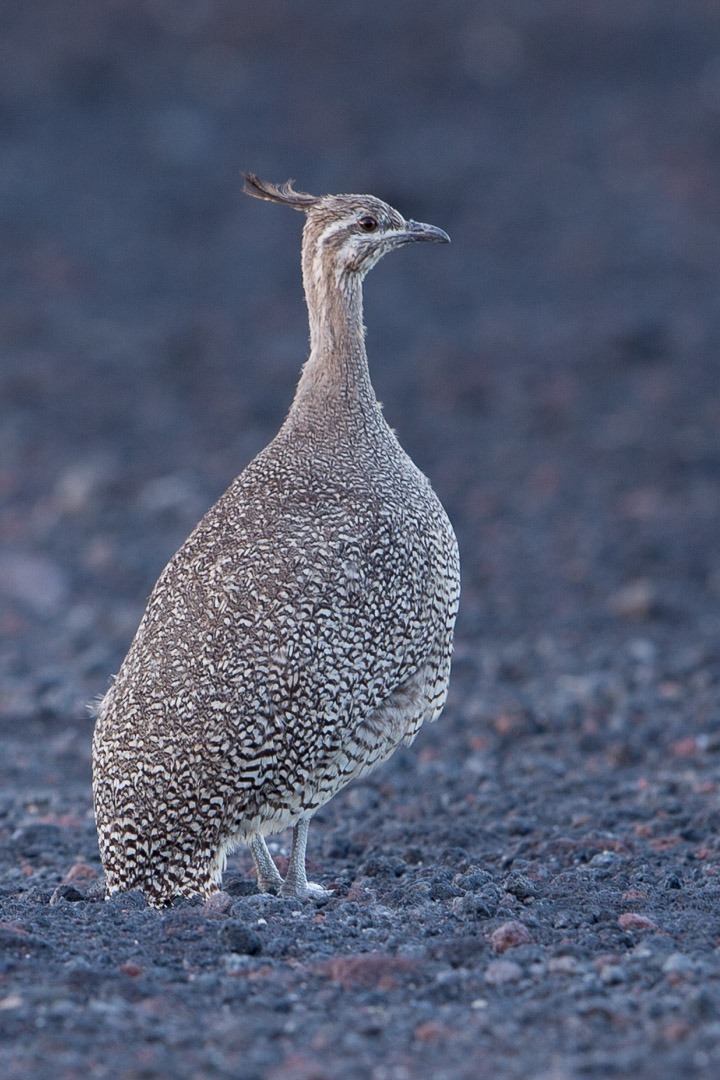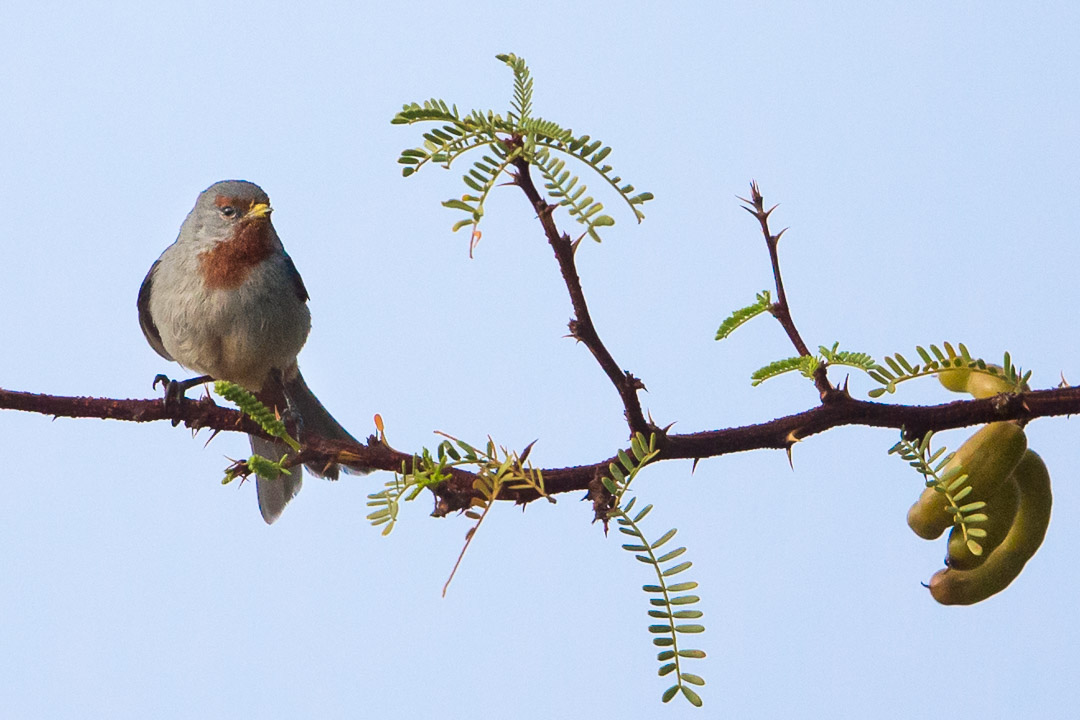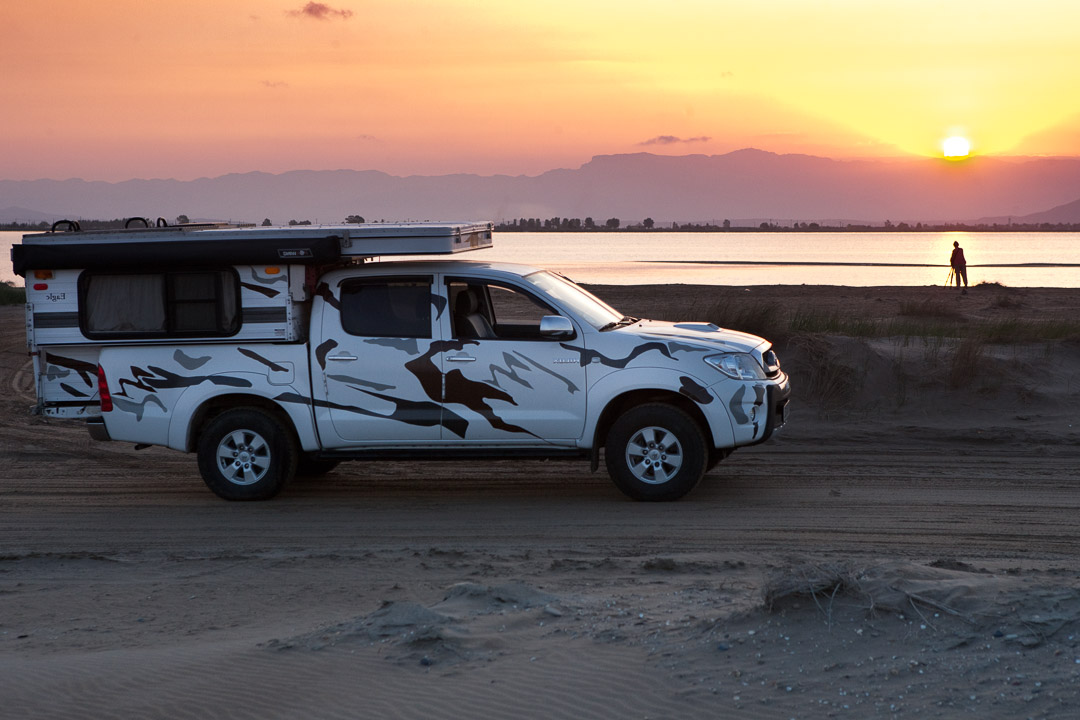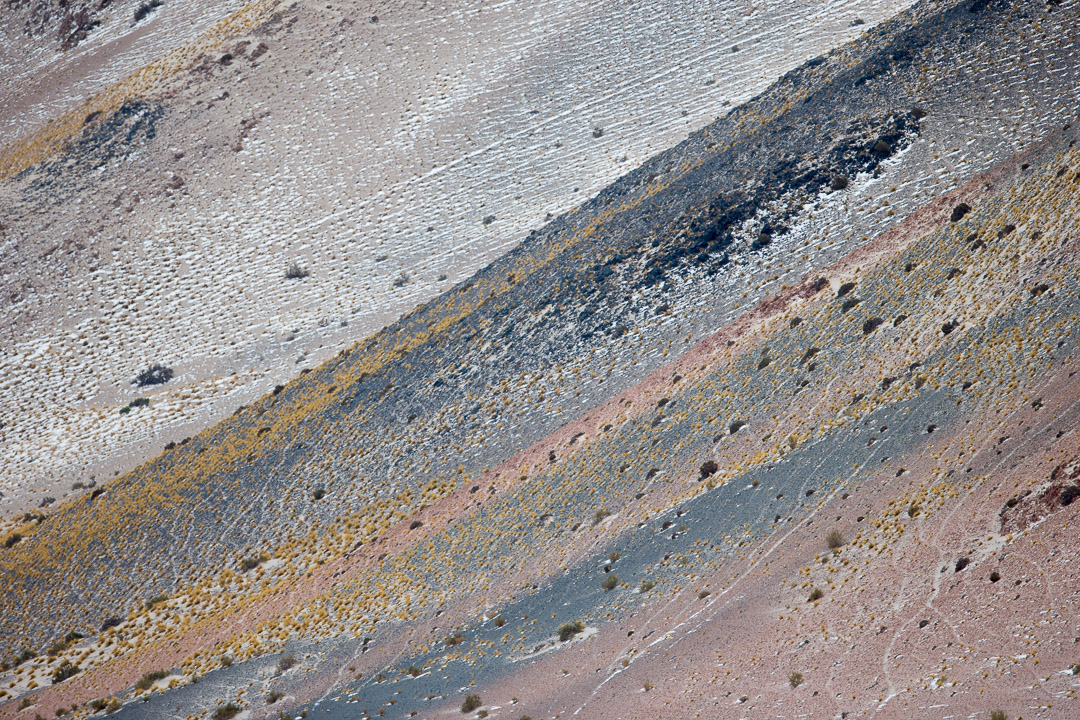Photo Blog
Names of animals are fascinating, especially those of birds. There is a heron that lives in Argentina. It has a beautiful plumage, tan and black with orange and white patterning, the colours of dried grasses waving in the wind. A Tiger like Heron, called the Rufescent Tiger-heron.
As the heron stalks through its marshland home it is easy to spot in the open but when the bird is amongst the reeds and sedges, it is camouflaged perfectly.
When it flies it shows its chequered markings superbly. It is no wonder that so many birdwatchers visit South America to see birds as magnificent as the Rufescent Tiger Heron.
These photographs are of Juveniles. Often in nature it is the juveniles or females that are better camouflaged. The reasons being that juveniles of most species are less equipped to look after and defend themselves, they need to hide more often. It is usual for females to incubate eggs and remain hidden whilst on the nest.
One can also understand why it has ‘Tiger‘ in its name.
Adults will sometimes adopt other strategies.
This adult Rufescent Tiger-heron is quite differently plumaged, with rich chestnut and white stripes down its throat. For adults and especially males, plumage and colouration is more connected with the need to display to females or threaten other males.
Many herons and egrets also stand motionless in reeds to mimic the vertical lines and shapes of the marsh vegetation. Camouflage also helps an animal catch prey, much like the Tiger.
It’s a born hunter, a tiger like heron.
What vehicle would you choose, we choose the Toyota Hilux.
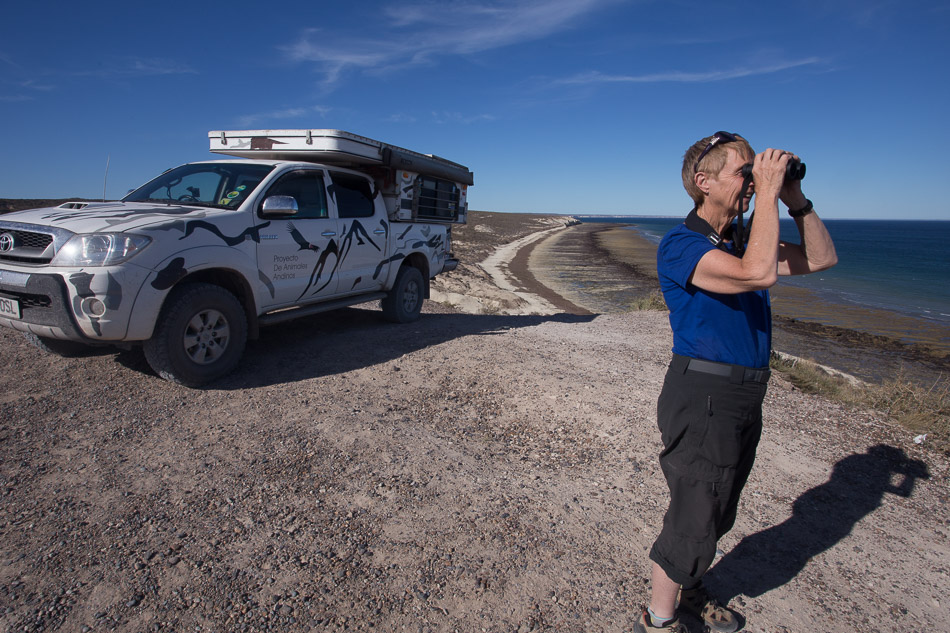
The Living Wild in South America overland expedition is currently operating in Argentina and Chile. The vehicle we use is the Toyota Hilux, one of the most durable and rugged 4×4 trucks in the world. We are wildlife photographers and film makers, every day is an adventure. The car needs to be up to the challenge!
We have a lot of equipment for overland travel such as generators, tow ropes and car spares. For our wildlife photography and filming we have cameras, tripods, sound recording equipment and hides. Then there is our personal clothes and sleeping bags, rucksacks and even lightweight tents for trekking, a lot of stuff – so we have removed the rear seat and this is where our gear is stored.
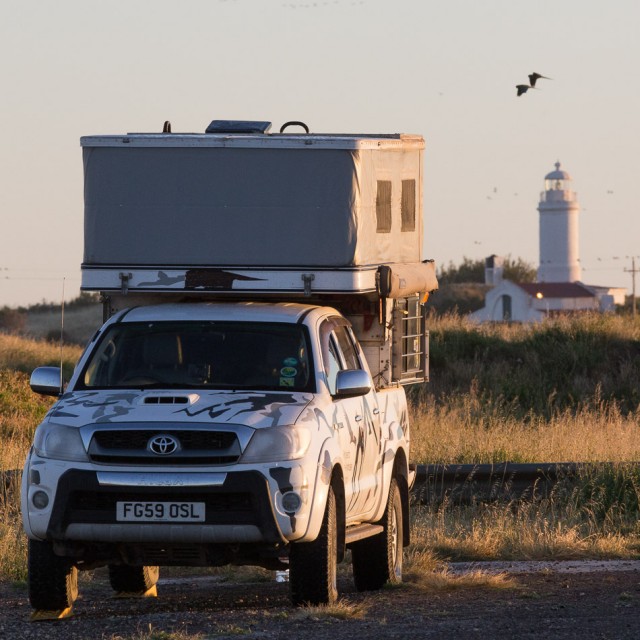
On the Toyota Hilux truck we have fitted a 4-wheel pop-up camper. This was imported from California and this is where we sleep, eat and work.
Travelling overland in the wilderness of South America, across the Andes, means that we go off-road. Rivers, sand dunes and rocks need negotiating so we need 4×4 capability. Sometimes this is a daunting task but one that is made easier knowing that we are driving a reliable vehicle. The Hilux model is even made in Argentina so that’s to our advantage too.
Everywhere we travel in South America the Hilux is the most wanted, most driven, most seen off-road car.
Is the Toyota Hilux the best 4×4, we think so.
Travelling through NW Argentina and up towards the magical Puna, the foothills of the Andes where the air is thin, we encounter an incredible landscape.
This is the Los Cardones National Park, 600 sq miles of high altitude semi-desert, taking its name from the wonderful Cardon Cactus, the biggest cactus in the world.
Although this is a desert, night time temperatures frequently drop below freezing and on rare occasions it even snows. For a week, our ‘Living Wild in South America’ expedition stayed in the area studying the high desert wildlife.
The natural history is specialized, the plants extraordinary and the landscape stark and beautiful. Dominating the scene is the majestic Cardon, standing proudly above the low vegetation.
The Cardon Cactus is slow growing and long lived, the one pictured above is probably 250 years old.
The Cactus has deep fleshy lobes separated by grooves running its length. This way it greatly enlarges its surface area and so enables it to catch more sunlight and therefore produce more Chlorophyll., the energy creator of all plants.
The first 10 years is most critical for the young cactus. Its skin is thin and tender and requires shelter from both the intense cold and the strong midday sun.
A young cactus will only grow and develop in the shelter of a Larrea, otherwise called the creosote bush.
This low spiky plant is a vital part of Cactus eco-system, without which the Cardon could not grow
Why is there a hole in one of these shells?
We found them alongside a small lake while we were bird watching in the Ibera marshes, Argentina. The area was teaming with wildlife, herons, egrets and a great freshwater reptile, called a Caiman.
But this is the bird that was responsible. The Snail Kite finds freshwater snails are yummy and so they comprise a large proportion of its diet.
The bird is highly specialized. It sees the snail under the water, hovers and dives down, grips it with its very long talons and flies to a perch. Then using its sharp and scimitar like bill, it punctures a hole in the thin shell and by dexterous twists and turns pulls out the snail and eats it.
The Snail Kite feeds exclusively on snails and being a freshwater specialist is always likely to find itself prone to habitat loss, but currently the Snail Kite has a large range and is not threatened.
… and I thought only the French eat snails.
Apart from man, the American Kestrel could be considered as the most successful vertebrate predator in the Americas. Its breeding range extends from Arctic Canada down almost to Tierra del Fuego, an amazing 13,000 miles.
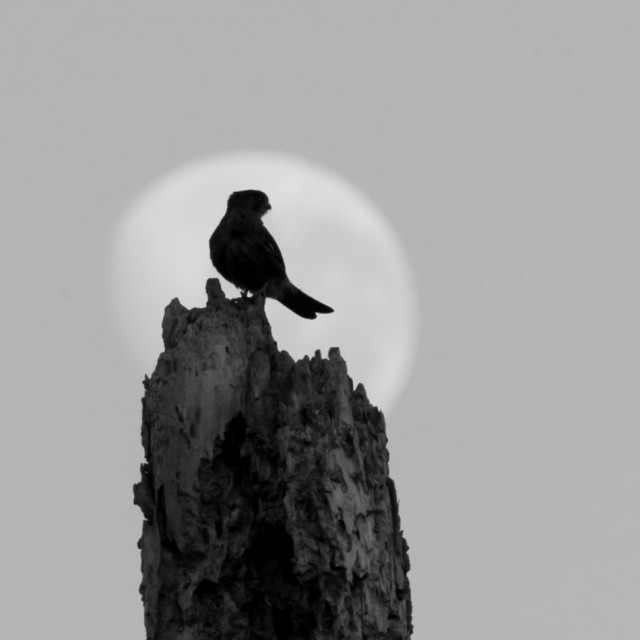
Every birdwatcher in America will have seen this bird and even those who do not consider themselves birdwatchers, but are generally interested in wildlife, will also have seen a Kestrel. This diminutive predator loves to perch in prominent places and has the habit of ‘hovering‘ in flight.
These habits make the bird easy to spot. If you want to encourage a child to be interested in nature and wildlife, this is a good bird to start with. On long road journeys as a kid, my dad used to get us all to count them as we drove along.

Throughout their enormous range the kestrel has developed into seventeen sub-species, each one geographically separated from the other. To be successful an animal needs to be flexible in where it lives and what it feeds on and the American Kestrel has been great at doing that. They feed on small rodents and insects and so in those areas where intensive agriculture predominates, particularly where chemicals are used, kestrels do not do well.
They breed mostly in trees but are equally at home on the ledges of high rise urban blocks or old buildings in the countryside. The American Kestrel is even expanding its range and taking advantage of deforestation in various parts of its range such as Amazon. This is one animal that is a 21st century winner.
Yavi Chico, the northernmost school in Argentina.
We parked close to the village school and stayed a few days. During that time we were invited into the school several times and joined them at mealtimes. For Argentina this was a poor area, so the school supplied the children with three meals a day.
We entertained the teachers and children by showing them presentations about our work, where we come from and about the culture of Great Britain. Finally we shared with them our images of the amazing nature and wildlife of Argentina.
The staple crop grown in the area is maize and so the school was famous for developing its entire curriculum around the important maize plant. Maths, geography, art and craft lessons all focused on maize.
We took the children and their teachers out for a nature walk. The kids played in a pond, the concept of pond dipping to see wildlife was entirely new to them.
They were amazed when they caught a freshwater crayfish.
Argentina has a wonderful and valuable wildlife, generally under valued by its people, but this is no different from most places in the world.
What we aim to show children, is the wonder of nature and the valuable role wildlife plays in protecting their surroundings. Hopefully then, the children will grow up to appreciate the importance of the wildlife where they live.
The livelihoods of many birds change with the wind and sea currents, especially in an El Niño year.
The 1998 El Niño was the strongest recorded in the 20th Century. Consequently the marine life of the Humboldt Current plummetted and so did the fortunes of many birds and marine mammals, particularly the numerous Guanay Cormorant, a threatened bird of Chile and Peru.
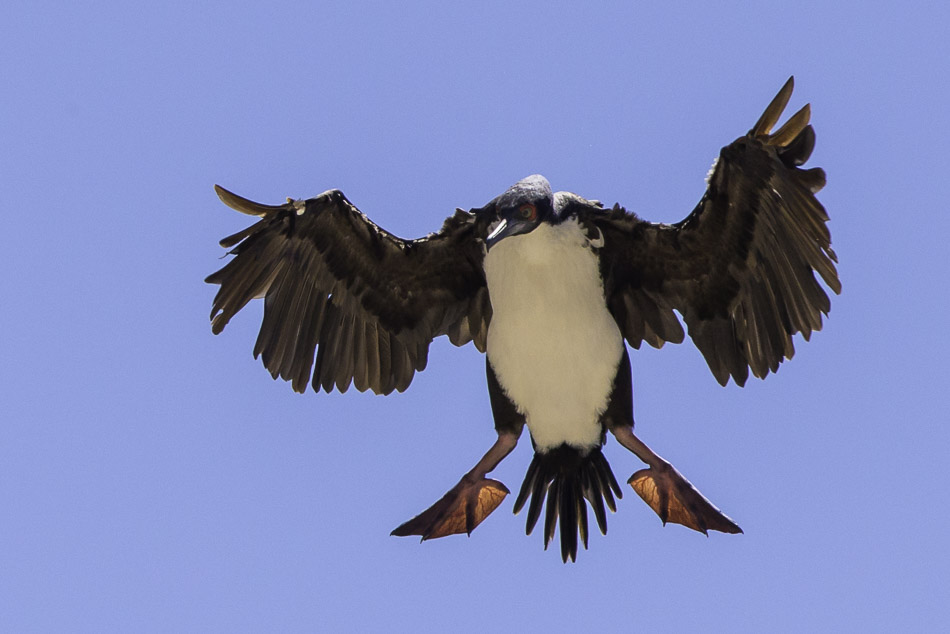
This bird was once dubbed ‘the most valuable bird in the world’ on account of the millions of tonnes of nitrogen rich guano exported from its breeding grounds, during the 19th century.
 The Guanay Cormorant feeds almost exclusively on anchovy, which require the cold water seas of the Humboldt. In El Niño years, the sea temperature increases and this severely diminishes all marine life.
The Guanay Cormorant feeds almost exclusively on anchovy, which require the cold water seas of the Humboldt. In El Niño years, the sea temperature increases and this severely diminishes all marine life.
Last year the Living Wild in South America expedition arrived at the Chilean coast and we were pleased to see that populations of the Guanay Cormorant appeared to be doing well.
2015 was another El Niño year, not as strong as in 1998 but the Guanay Cormorant, the El Niño bird, still suffered breeding losses and only a proper census can ascertain the true population.
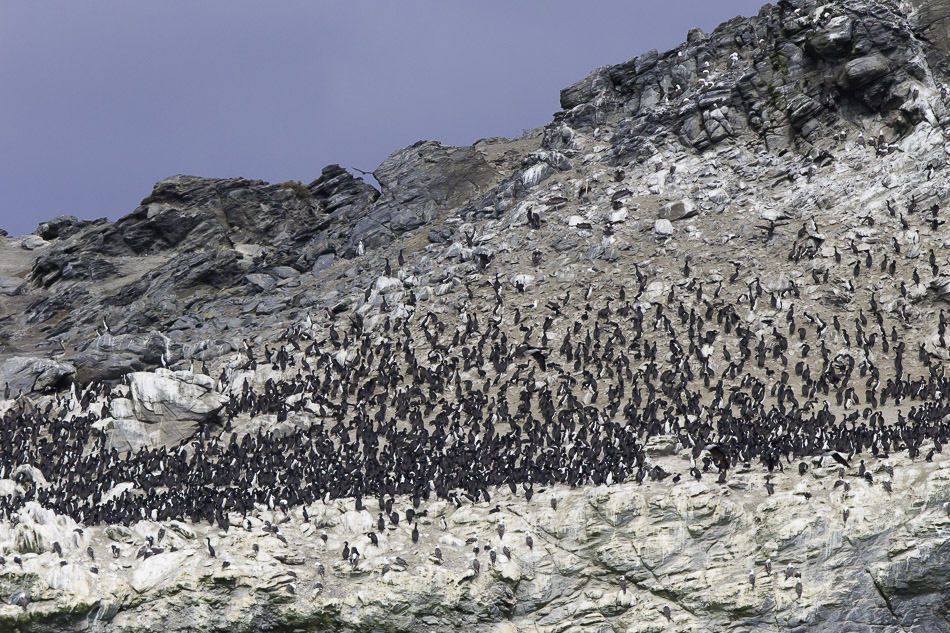
Peru and Chile have limits to their anchovy fishing catch, but they are not sufficiently controlled and long term sustainability remains in the balance. In addition up to 20,000 birds are trapped annually for food in Peru.
90% of the breeding Guanay Cormorants are confined to a narrow part of the Chilean and Peruvian coast and one of the best places to see the birds are at the Reserva Nacional Pingüino de Humboldt in Chile. This is about 500km north of Santiago. There are a number of good camp sites at Punta Choros as well as many small guesthouses.
Boats are available most of the year, but the best time to visit is September and October. This is the time when most seabirds are breeding and also the best time to see Humpback, Fin and possibly Blue Whales which appear off the coast.
Palm Savannah is a threatened habitat. Today, only isolated fragments remain.
Around 80 per cent of land in Uruguay is used for agriculture, most of it for cattle ranching. Intensive grazing and deforestation has destroyed much of the palm savanna that once covered the south of Brazil, Uruguay and north-east Argentina.
Conserving native tree species in South America is important. For the Yatay Palm it’s vital as there are so few left. Conservation of the Palm savannah is crucial in maintaining biological diversity and ecological integrity as the trees produce edible fruits, food for many birds and mammals.
The best place to see the Yatay Palm is the El Palmar National Park, located in the province of Entre Rios, Argentina. El Palmar is also a great place for wildlife photography, it is situated on the banks of the great river Uruguay and sometimes the mist rises off the river at dawn and drifts between the Palm forests, creating a sublime atmospheric setting for the magnificent trees.
El Palmar is also an ideal place for bird watching and has a good camp site in the park where food, showers and washing facilities are available.
There is a rainforest tree which seems to set the forest on fire.
This is the Ceibo, the national tree and flower of Argentina. It has inspired tangos, poetry and folk music as a symbol of courage and strength in the face of adversity.
This tree is at its best when seen amid a great rainforest. This is how Paula and I first saw it in springtime in Calilegua National Park, draped with moss and bursting from the forest canopy like an exploding volcano.
Our ‘Living Wild in South America’ expedition visited Calilegua in 2014, the Ceibo trees seemed as if they were on fire and masses of raucous Red-Mitred Parrots were feeding on the scarlet flowers
The Ceibo tree is revered in Argentina and plays a major role in folklore.
According to legend, there was once an indigenous woman named Anahí who lived on the shores of the Paraná River. She was small and unsightly, however her looks were forgotten on summer nights when she came to sing with her beautiful voice to her tribe about their gods and the love of their land.
When the conquistadors came to conquer the land, they took Anahí and others from her tribe as prisoners. One night, the guard of her cell fell asleep and Anahí saw a chance to escape. The guard, however, woke up just as she was getting away and so she stabbed him. His dying shout startled the rest of the soldiers and Anahí was unable to escape. Her punishment for killing the man was to be burnt at the stake.
On the night of her sentence, she was tied to a tree and a fire was lit. The flames quickly caught and Anahí began to sing to her land.
The following morning, the soldiers stood astounded at the spot of her death.
In place of the ashes they had expected to find, there was a blooming Ceibo tree showing off its splendid red flowers.
Millions of years ago there was a family of truly ‘giant’, but flightless, birds, the Moas of New Zealand, the Elephant birds of Madagascar and the Terror birds of South America. Some of these birds stood 10 feet high and laid eggs the size of dustbins.
To-day, our biggest birds, the Ostriches of Africa, the Cassowaries of Australia and the Emus and the Rheas of South America are related directly to these ancient giants and along with them are a few other smaller birds such as the Kiwis of New Zealand and the Tinamous of South America.
One aspect of their biology that links all these birds is the structure of their feathers. When you see a bird preening, it is ‘zipping’ its feathers together, this ensures that each feather is tightly connected, enabling smooth and effective flight. Like their ancient ancestors, the Tinamous and Rheas of South America have split feather shafts that cannot be ‘zipped’ together and is the main reason why Rheas are not capable to fly and Tinamous, only poorly and then for very short distances.
The Tinamous rely on their cryptic camouflage to avoid detection by predators.
Paula and I have seen a few species, but they are notoriously difficult to photograph.
Above is pair of Elegant-Crested Tinamous, a common and widespread species of the Monte desert.
The image below is of the Ornate Tinamou a species of the Pre-puna and High Andean Steppes.
A Quebracho Crested-Tinamou which we saw in the Copo National Park, in the province of Santiago del Estero, Argentina. The Copo National Park is difficult to access, the last 25 km being along a rough dirt track, in dry weather any vehicle can get through but if it is wet, the road is treacherous and only possible with 4×4 capabilty.
There are no facilities at all in the Copo National Park, but its a great location for birdwatching and for wildlife photography.
Nothuras are very closely related to Tinamous. This Spotted Nothura was photographed in the Ibera Marshes, Corrientes, Argentina.
Farming and wildlife is a hot contentious issue around the world.
I’m not going to enter the debate here, but just show a photography taken in Argentina, that illustrates the subject. The bird is a Brown & Yellow Marshbird and whilst this grassland bird is still fairly common in Southern South America, many other species are becoming quite rare.
How many layers can you see?
Paula and I were on the Valdes peninsula, on the Argentinain coast.
The tide was out and we were just looking, at nothing in particular, just looking. Gradually it dawned on us that we were seeing something quite special, a beautiful combination of colours, layer upon layer. Beauty for free.
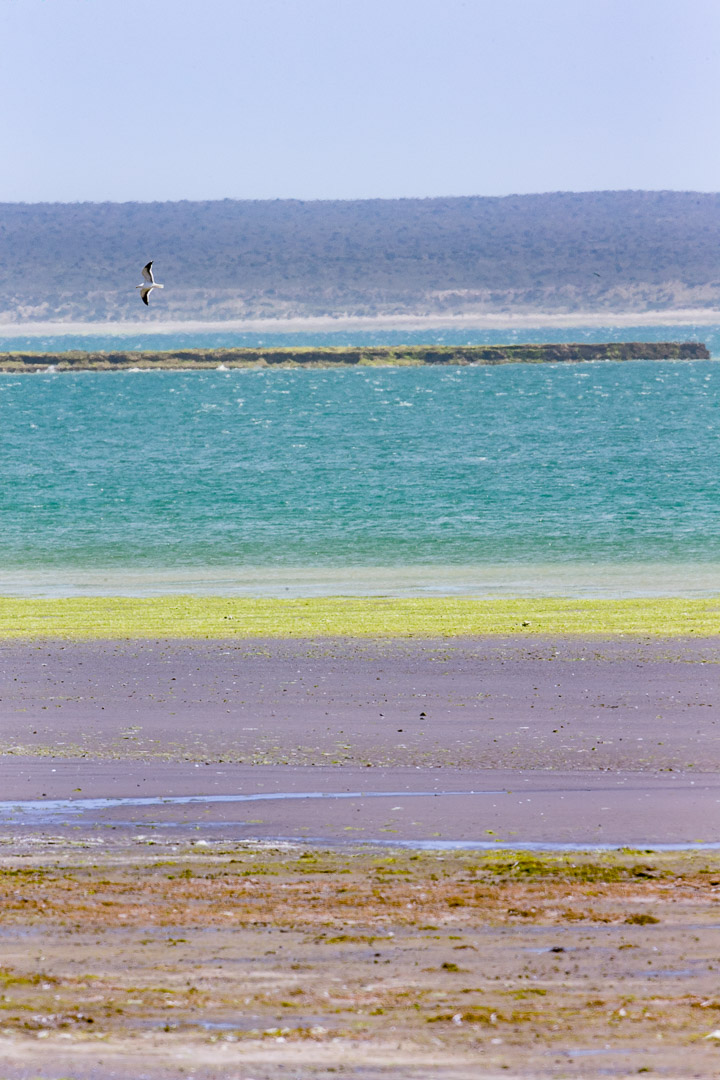
Where ever you are, look at the view before you and we hope you see some beauty as well.
Most people except farmers like foxes. Farmers think them to be sly, crafty and villainous, which they are.
We like foxes because they are a successful predator in a global environment dominated by man. An animal has to be smart to do well in our world and foxes are smart.
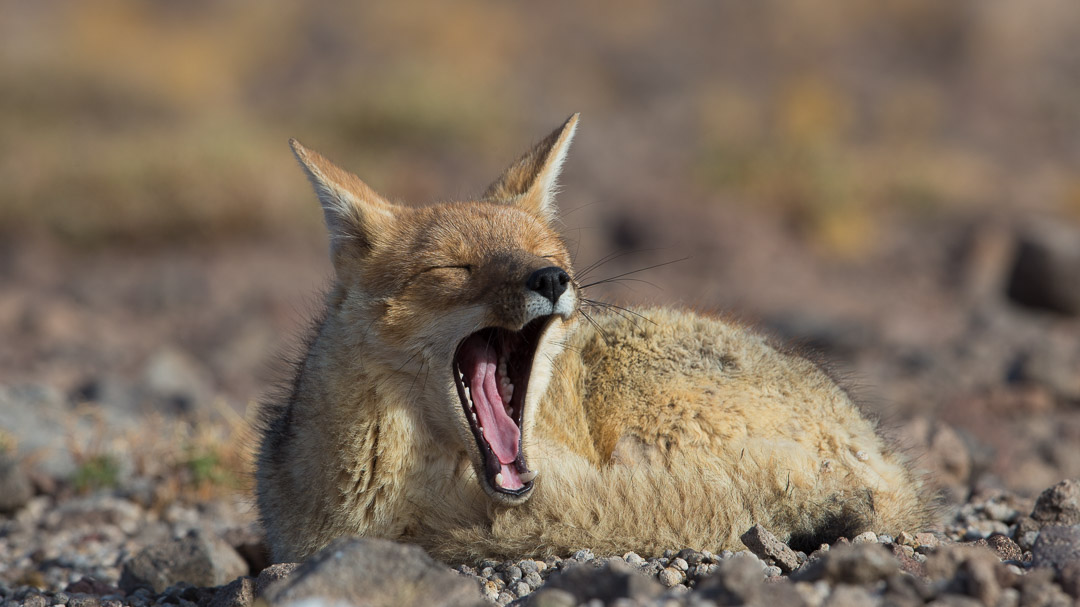
The South American Gray fox is otherwise known as the Patagonian Fox, the Chilla, the Grey zorro ,the Culpeo Fox or the Andean Fox. So many local names indicate it is well known in legend and folklore.
The most interesting aspect about this animal is that its not a true fox genetically but more closer related to the Coyote and Wolf. Just because it looks like an average fox its called a fox, but deep down its true nature is not fox like at all, more Wolf.
We refer to them as Andean foxes and the first one we saw was in the ‘jaw droppingly’ spectacular Tres Cruces National Park in Chile, South America.
On our ‘Living Wild in South America, expedition we camped overnight at this spot, but at 4300m high we didn’t get the best nights sleep. I woke at dawn and staggered outside and I’m glad I did, as this sunrise greeted me.
Later that morning we came across an Andean Fox asleep.
I got out my camera, sat down and waited. The fox was quite unconcerned, wildlife in the Andes see few people and even fewer camping, on our travels to date we have seen no one camping in these remote areas.
Eventually the animal woke up, yawned, and went back to sleep again. We waited and waited and eventually the animal got up and wandered right by us, towards our vehicle. We were a little concerned as we had left the doors open, we thought the fox might jump inside and go to sleep again. But it had a pee against the wheel of car and sauntered off.
We felt privileged to have spent an hour in close proximity to the fox, or was it a wolf in foxs’s clothing.
Villa Carmen is situated in the spectacular Manu Biosphere Reserve in Southern Peru, containing special birds like this Pygmy Antwren.
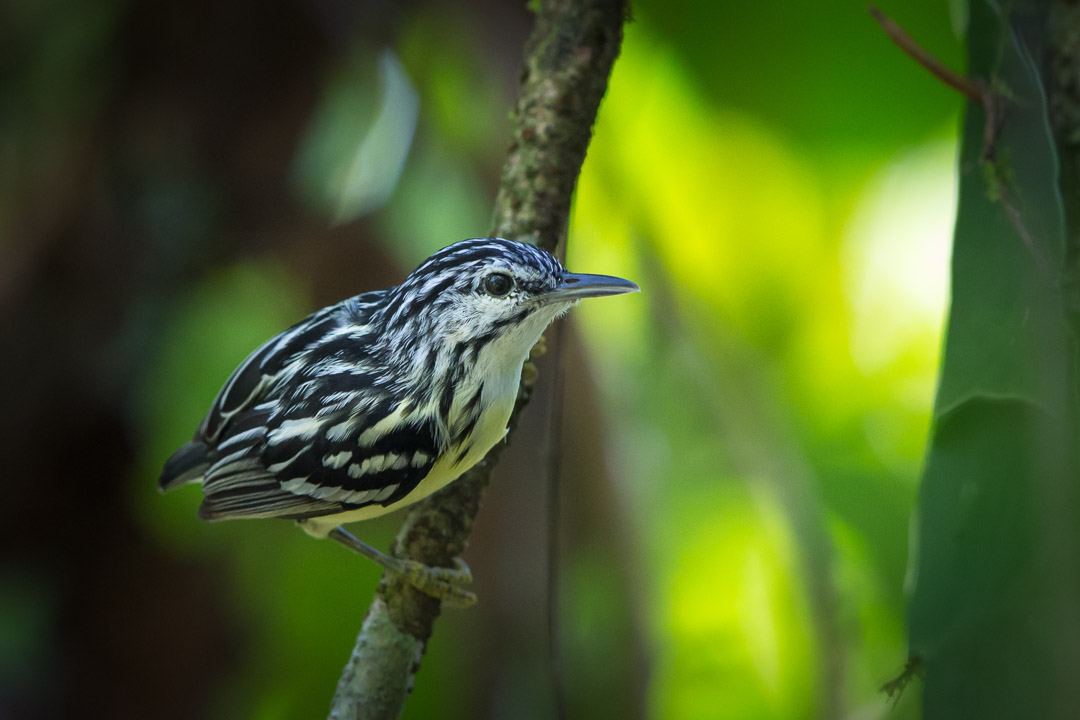
A landscape of hills covered in tropical forest.
The Manu road is reached by driving 4 hours south of Cuzco, the fabled capital of the Inca. It goes up the Andes and then follows a circuitous route from 4500m down the eastern slope, through a series of lush forest eco-regions into the lowlands of the Amazon basin. For the birder, naturalist, wildlife photographer and any true traveler and explorer, this road will open your eyes to the majesty of the Peruvian Andes.
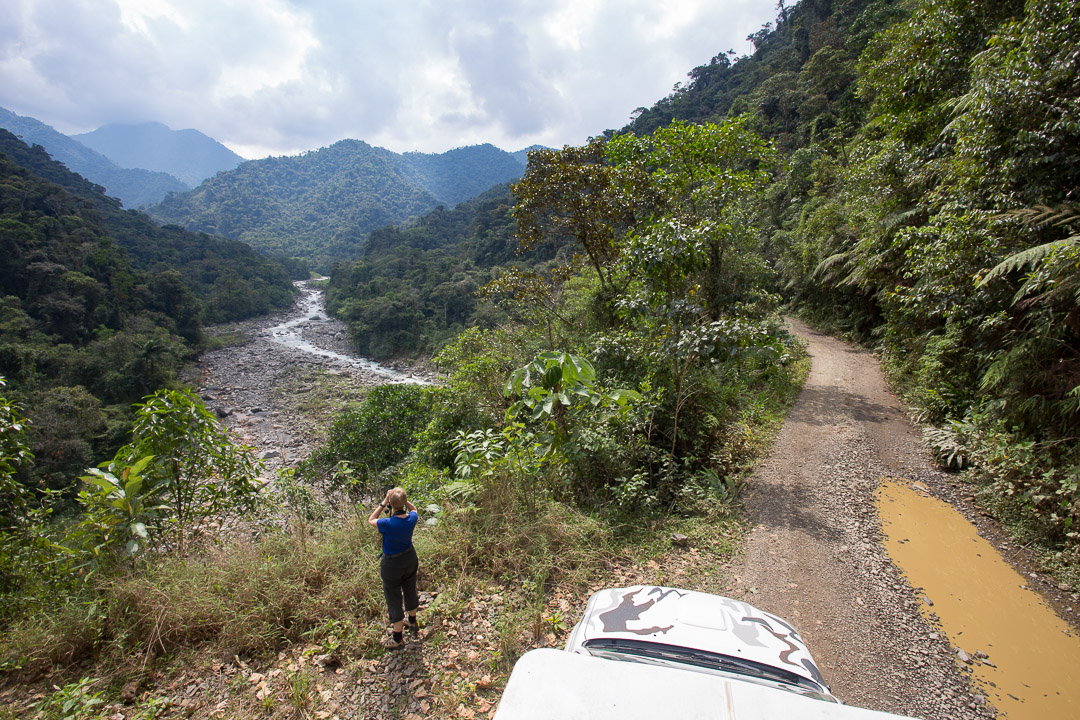
The road itself is not good, tight bends, potholes, fallen rocks and other traffic make it a slow journey. Avoid the wet season of December, January and February as severe rain adds seriously to the difficulties and often the road is closed for short periods. Otherwise drive carefully and enjoy the profuse birds that can be seen by regularly stopping. For birders to make the most of the environment its worth stopping en-route at one or more of the lodges. Villa Carmen is at least 2 hours driving from Wayquecha, but birding en route can stretch that to 4 hours easily.
Villa Carmen is almost at the end of the Manu road and therefore quite low down. At 500m Villa Carmen avoids the worst of the stupifying humidity deep in the amazon basin, but it is still hot.
Visiting birders not used to the heat will love Villa Carmen as it is much more comfortable than either Wayquecha or Cock of the Rock. An added bonus is that the bedrooms and showers are first class. There were days at Villa Carmen that we were showering 3 times a day to cool ourselves down after a session birdwatching.
The birds are fabulous too, like the Golden-fronted Piculet.
The Blue-throated Guan
& the Andean Guan.
There is no better road to bird down, IN THE WORLD, than the Manu road in Peru, South America.
The Manu road is reached by driving 4 hours south of Cuzco, the fabled capital of the Inca. It goes up the Andes and then follows a circuitous route from 4500m down the eastern slope, through a series of lush forest eco-regions into the lowlands of the Amazon basin. For the birder, naturalist, wildlife photographer and any true traveler and explorer, this road will open your eyes to the majesty of the Peruvian Andes.
The road itself is not good, tight bends, potholes, fallen rocks and other traffic make it a slow journey. Avoid the wet season of December, January and February as severe rain adds seriously to the difficulties and often the road is closed for short periods. Otherwise drive carefully and enjoy the profuse birds that can be seen by regularly stopping. For birders to make the most of the environment its worth stopping en-route at one or more of the lodges. The lodge highest up and located in the cloud forest is Wayquecha, further down the road is another memorable Lodge.
The Cock of the Rock lodge is one of the next lodges down the Manu road, at an elevation of 1600 m and the tropical forest surroundings harbor a very different contingent of birds.
This is Paula in the dining room and lounge at Cock of the Rock, this room doubles up as an open balcony overlooking a series of hummingbird feeders from which the following images were taken.
Sparkling Violet-ear Hummingbird
Blue-Crowned Motmot
There are miles of walking trails at Cock of the Rock Lodge, these and the balcony are sufficient reasons to stay, but the real reason why so many birdwatchers and wildlife photographers visit is to hopefully see one of South America’s most enigmatic birds, the bird after which the lodge is named.
The Cock of the Rock, a ruby that shines in the darkness and this is the place to see them at their courtship lek.
We stopped only one night at Cock of the Rock, which we shouldn’t have done, we could have stayed a month quite happily. The ‘Living Wild in South America’ expeditions will return to Southern Peru in the future, then we will stay longer and bird watch at leisure.
There is no better road to bird down, IN THE WORLD, than the Manu road in Peru, South America.
The Manu road is reached by driving 4 hours south of Cuzco, the fabled capital of the Inca. It goes up the Andes and then follows a circuitous route from 4500m down the eastern slope, through a series of lush forest eco-regions into the lowlands of the Amazon basin. For the birder, naturalist, wildlife photographer and any true traveler and explorer, this road will open your eyes to the majesty of the Peruvian Andes.
The road itself is not good, tight bends,potholes, fallen rocks and other traffic make it a slow journey. Avoid the wet season of December, January and February as severe rain adds seriously to the difficulties and often the road is closed for short periods. Otherwise drive carefully and enjoy the profuse birds that can be seen by regularly stopping. For birders to make the most of the environment its worth stopping en-route at one or more of the lodges.
Manu Road birding Lodge No 1 is the Wayquecha Biological Research Station. This is located at an elevation of 3500m in the cloud forest.
The image above shows Paula and I together with the Wayquecha Science Officer Vanessa Luna and the resident guide Pancheto.
Wayquecha has one of the few easily accessible canopy walkways in Peru and has many well maintained trails, though some are narrow and steep. This is Paula walking on a typical Wayquecha trail. We were there as an expedition, part of our ‘Living Wild in South America’ project, one of the greatest Birding Adventures in the World.
This is the dining room. It looks out over an Andean vista of mountains and forest. You are perched on top of the World, all you have to do is watch the birds pass by and there are many.
The Grey-breasted Toucanet
Scarlet Bellied Mountain Tanager
and Masked Flowerpiercer.
Wayquecha has hundreds of potential bird species that a visiting birdwatcher might find. Stopping here is just the start of a journey down the Manu Road. Watch out for two more blogs which will outline the advantages of two further birding lodges, one of the best birding routes in South America.
The human eye can differentiate up to 450 shades of grey.
We met this woman as she was herding her Llamas over the high Andean Puna in Argentina. She was reticent when we met and frowned when I produced a camera. I offered her a bar of Cadbury’s chocolate we had brought out from the UK and her face lit up. Faces are made to smile not to frown.
But when it comes to colour it is thought we are sensitive to a 100 million distinct colours. As photographers therefore our belief is that a photograph taken in black and white greatly simplifies the image. Stripping out the unnecessary detail of colour leaves behind outlines and shapes so important in composition.
Flamingoes live and even breed at altitudes up to 15,000 ft in the Andes. The climate for animals is as harsh as anywhere in the World. Under their outer coat of feathers they have a thick undercoat of the most delicate feathers imaginable. This macro photograph shows their fine structure.
Paula and I on our ‘Living Wild in South America’ expedition are using our cameras every day. Our eyes are bombarded by stimuli and often we have to think hard as to how best to photograph a scene before us.
This is a beach on Argentina’s Atlantic coast. The fishermen had colourful tents on the beach, distracting from the more important people.
The curvature of the bay is enhanced by the striking interplay of light on the sea.

Imagining what the image will look like in Black and White, before we press the shutter, is a strategy that helps us.
We were driving along an interminable road across the Atacama desert. It was almost featureless and baking hot. This was an image that shouted out to us as we drove past. We quickly pulled over and waited for the traffic to ease off. This is just how we remember the Atacama.
The Guira Cuckoo is a bird found in the savannas of South America. Birdwatchers will find it easily as it is a noisy, social and communal bird and we have seen flocks of up to twenty. The Guira Cuckoo has a fascinating life history.
Paula and I, on one of our” Living Wild in South America” birdwatching expeditions in Argentina came across a broken egg of the Guira Cuckoo lying on the ground, it was so beautiful we had to take a macro photograph of it.
The colouration of Bird’s eggs are very special and the Guira Cuckoo’s egg is no exception. Perhaps the lattice work and filigree patterning of white against jade green is particular to each individual bird. The white splashes maybe help to strengthen the egg. Who knows? We take birds eggs for granted, they are a hidden secret, part of the glorious nature and wildlife of South America.
For birdwatchers visiting South America, the Atacama desert in Chile and the Monte and Patagonian deserts in Argentina are challenging destinations.
The landscapes are stunning and great for photographers but birdwatchers have to work hard. The rewards though are worth it as there are a host of endemic birds to be found.
There are the Earthcreepers, a family of birds related to the ovenbirds, one of the biggest bird families in the World.
One of the ‘Living Wild in South America’ expeditions camped in the Monte desert region in Northwest Argentina and we came across a Scale-throated Earthcreeper. We watched it for some time as it scratched the ground, sending stony debris into the air. Eventually after 10 minutes it pulled from the ground a long invertebrate larva
There is also the Straight-billed Earthcreeper, we found this bird in the province of Mendoza.
Ground-Tyrants are small passerine members of the Tyrant-Flycatcher family, there are about 13 species and most inhabit arid landscapes. The species seen above is the Ochre-naped Ground Tyrant.
One family of birds that inhabit arid lands and deserts are the Tinamous, a family of birds endemic to South America, distantly related to the Rhea and Ostrich and even to the biggest true bird ever to inhabit the World, the prehistoric elephant bird. There are 46 species and all are confined to Central and South America.
The most common in the southern cone of the continent is the Elegant-crested Tinamou, easy to see but quite difficult to photograph.
More difficult to see and even more tricky to photograph is the Ornate Tinamou. The reasons for this difficulty are that all Tinamous have long been sought after for food and that they have intricately patterned plumage, enabling them to be cryptically camouflaged in the desert scrub.
Up in northern Chile, deep in the Atacama desert are a few oases. In some a special tree grows, the Tamarugo tree, related to the Prosopis. In such places you can find a Chilean endemic bird, the Tamarugo Conebill.
Birding South America’s deserts is rewarding and there are many other groups of birds to be found, the Sierra-finches, Doves, Miners and Gallitos for instance.
Both Chile and Argentina welcome birdwatchers and many tours operate in the areas.
For more specific information on Birding in South America’s deserts and Neotropic birding generally, google the Neotropic Bird Club.
Paula and I are photographers specializing in wildlife and we love seeing the textures of the high desert.

Our overland expedition called ‘Living Wild in South America’ has visited many remote deserts.
Our vehicle is a 4×4 Toyota Hilux, one of the most popular cars for accessing the desert terrain in Argentina and Chile .
Desert regions, despite the harshness of their environment, can produce some of the most captivating scenery in the World. South America has one of the driest anywhere, the 600 mile long Atacama desert in Chile. There are places here where it hasn’t rained for 100 years.
Not all deserts are barren, the Tamarisk, is a drought tolerant plant that often grows alongside tracks. The hard sand tracks collect what little moisture may be around and this is where the Tamarisk is to be seen.
The image above is a desert scree slope, it is a delicate series of shades and textures – orange, blue, grey, tan, green and purple. Winding through it are tiny tracks where Vicuna have passed. The whole scene is flecked with newly fallen snow.
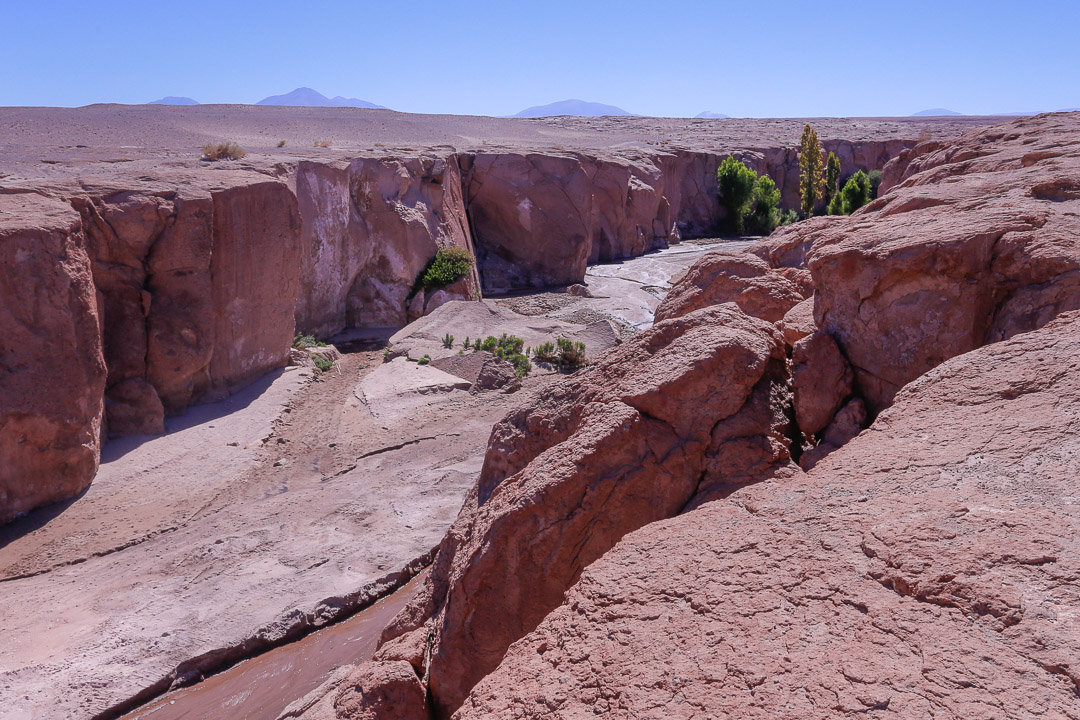
One of the most visited parts of Northern Chile is the town of San Pedro de Atacama. The landscapes around this town are spectacular and tourist excursions often take people to the Valley of the Moon. Close by is the village of Toconao, which is en route to the Salar de Atacama. Toconao is well worth the visit and has an impressive gorge that cuts through the desert. You’ll also find the accommodation here a lot cheaper than in San Pedro de Atacama. We stayed in the Complejo Turistico El Toconar which was luxury to us after 6 months living in our tiny camper!

